Paul van Yperen's Blog, page 152
August 7, 2021
Michel Strogoff (1936)
One of the best film adaptations of Jules Verne's 1876 novel is the French sound version Michel Strogoff (Jacques de Baroncelli, Richard Eichberg, 1936) starring Adolf Wohlbrück as Michel. It was made by the French subsidiary of Tobis Film and shot at the Epinay Studios in Paris and the Johannisthal Studios in Berlin. Location shooting took place mainly in Bulgaria and at the Johannisthal Air Field. A separate German version, Der Kurier des Zaren/The Czar's Courier (Richard Eichberg, 1936), was made also with Wohlbrück as Michel. A year later, an American version followed, The Soldier and the Lady (George Nicholls, Jr., 1937), produced by Pandro S. Berman. As his associate producer, Berman hired Russian film pioneer Joseph N. Ermolieff (Иосиф Николаевич Ермольев), who had produced the two earlier European versions. Berman also imported Wohlbrück, changing his name to Anton Walbrook to have him star in the American version. RKO Radio Pictures had purchased the rights to the French version and used footage from that film in the American production.
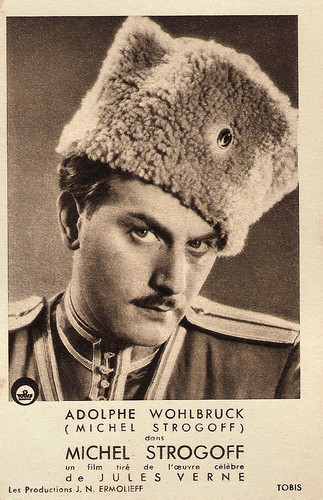
French postcard. Photo: Les Productions J.N. Ermolieff / Tobis. Adolf Wohlbrück as Michel in the French sound film Michel Strogoff (Jacques de Baroncelli, Richard Eichberg, 1936). Caption: A film based on the famous novel by Jules Verne.
Dark and handsome Anton Walbrook or Adolf Wohlbrück (1896-1967) was a distinguished Austrian actor who starred in early German sound films as Walzerkrieg (1933) and Viktor und Viktoria (1933). After the rise of Hitler, he settled in Great Britain where he appeared in such film classics as The Life and Death of Colonel Blimp (1943) and The Red Shoes (1948). He also played the ringmaster in La Ronde (1950).
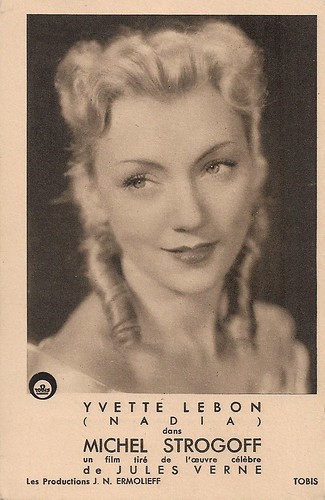
French postcard. Photo: Les productions J.N. Ermoliev / Tobis. Yvette Lebon as Nadia in the French version of Michel Strogoff (Jacques de Baroncelli, Richard Eichberg, 1936). Caption: A film based on the famous novel by Jules Verne. On the back: shown at the Cinema Stanislas, between Thursday 8 and Monday 12 October. Nancy had a Cinema Stanislas (opened in 1925), but e.g. also Lunéville had one. Thursday 8 October refers to the year 1936, the year the film was released. The film premiered in Paris on 10 March 1936.
French actress Yvette Lebon (1910-2014) appeared in 39 films between 1931 and 1972. Her beautiful eyes made her one of the most attractive faces of the French cinema of the 1930s.
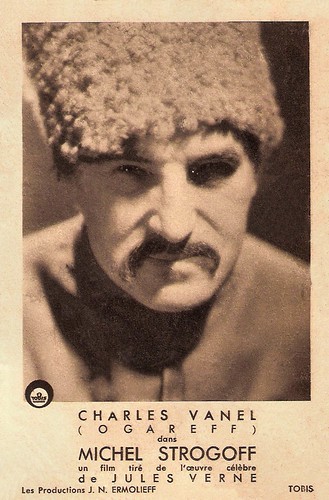
French postcard. Photo: Les productions J.N. Ermoliev / Tobis. Charles Vanel as the evil Ivan Ogareff in Michel Strogoff (Jacques de Baroncelli, 1936).
Charles Vanel (1892-1989) was a French actor and director. For 78 years, he had a career in film and played in over 200 silent and sound films, in France and abroad. He is best remembered for his roles as Javert in Les Misérables (Raymond Bernard, 1934), Charlot in La belle équipe (Julien Duvivier, 1936), the silent driver Jo in Le salaire de la peur (Henri-Georges Clouzot, 1953), the retired chief commissioner in Les diaboliques (Henri-Georges Clouzot, 1955), and the ex-resistance fighter in To Catch a Thief (Alfred Hitchcock, 1955), but he also played memorable parts in Italian films like Cadaveri eccellenti (1976) and Tre fratelli (1981), both by Francesco Rosi.
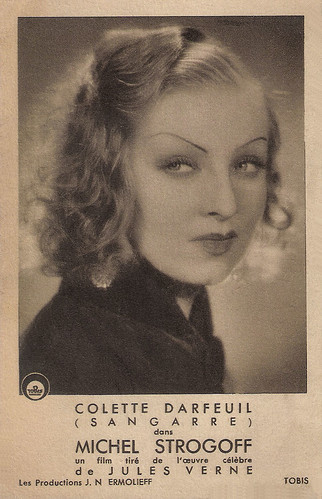
French postcard. Photo: Les productions J.N. Ermoliev / Tobis. Colette Darfeuil as the evil Sangarre, who plots together with Ivan Ogareff ( Charles Vanel ) in the French sound film Michel Strogoff (Jacques de Baroncelli, Richard Eichberg, 1936). Caption: A film based on the famous novel by Jules Verne. Postcard to promote the screening of the film at the Paris cinema Marivaux.
Coquettish Colette Darfeuil (1906-1998) was a French actress with beautiful green eyes who made 110 films between 1920 and 1953.
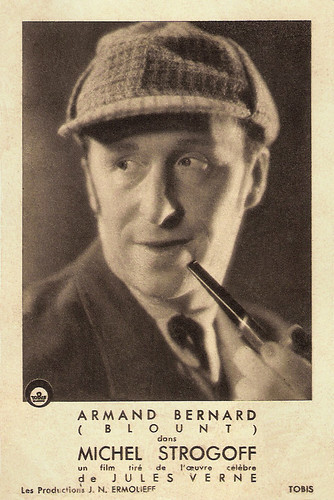
French postcard. Photo: Les productions J.N. Ermoliev / Tobis. Armand Bernard as the British correspondent Blount in the French sound film Michel Strogoff (Jacques de Baroncelli, Richard Eichberg, 1936). Caption: A film based on the famous novel by Jules Verne.
Armand Bernard (1893-1968) was a French actor, composer, and bandleader. With his heavy diction and his air of dignity, he brought a comical note to many French comedies.
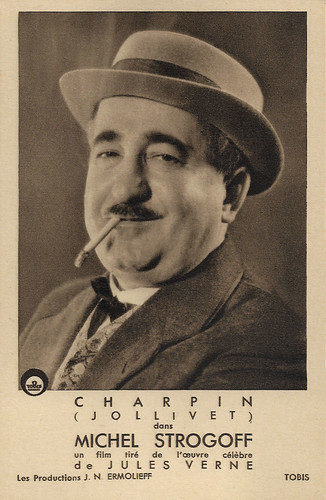
French postcard. Photo: Les productions J.N. Ermoliev / Tobis. Charpin as Jolivet in the French sound film Michel Strogoff (Jacques de Baroncelli, Richard Eichberg, 1936). Caption: A film based on the famous novel by Jules Verne.
Heavy-set French character actor and singer Fernand Charpin (1887-1944) was known as Charpin. His most famous role was Panisse, the wealthy widower who marries Fanny, in Marcel Pagnol's Marseille trilogy. He had a busy but relatively short career in the cinema.
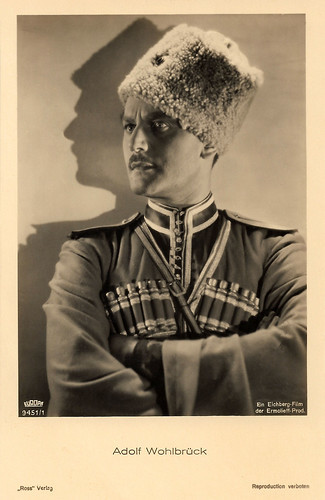
German postcard by Ross Verlag, no. 9451/1, 1935-1936. Photo: Europa / Eichberg Film / Les productions J.N. Ermoliev. Adolf Wohlbrück as Michel in Der Kurier des Zaren/The Czar's Courier (Richard Eichberg, 1936).
Sources: Wikipedia (English, French, and German), and IMDb.
Please, check out our earlier posts Michel Strogoff (1926) and Michel Strogoff by Albert Bergeret.

French postcard. Photo: Les Productions J.N. Ermolieff / Tobis. Adolf Wohlbrück as Michel in the French sound film Michel Strogoff (Jacques de Baroncelli, Richard Eichberg, 1936). Caption: A film based on the famous novel by Jules Verne.
Dark and handsome Anton Walbrook or Adolf Wohlbrück (1896-1967) was a distinguished Austrian actor who starred in early German sound films as Walzerkrieg (1933) and Viktor und Viktoria (1933). After the rise of Hitler, he settled in Great Britain where he appeared in such film classics as The Life and Death of Colonel Blimp (1943) and The Red Shoes (1948). He also played the ringmaster in La Ronde (1950).

French postcard. Photo: Les productions J.N. Ermoliev / Tobis. Yvette Lebon as Nadia in the French version of Michel Strogoff (Jacques de Baroncelli, Richard Eichberg, 1936). Caption: A film based on the famous novel by Jules Verne. On the back: shown at the Cinema Stanislas, between Thursday 8 and Monday 12 October. Nancy had a Cinema Stanislas (opened in 1925), but e.g. also Lunéville had one. Thursday 8 October refers to the year 1936, the year the film was released. The film premiered in Paris on 10 March 1936.
French actress Yvette Lebon (1910-2014) appeared in 39 films between 1931 and 1972. Her beautiful eyes made her one of the most attractive faces of the French cinema of the 1930s.

French postcard. Photo: Les productions J.N. Ermoliev / Tobis. Charles Vanel as the evil Ivan Ogareff in Michel Strogoff (Jacques de Baroncelli, 1936).
Charles Vanel (1892-1989) was a French actor and director. For 78 years, he had a career in film and played in over 200 silent and sound films, in France and abroad. He is best remembered for his roles as Javert in Les Misérables (Raymond Bernard, 1934), Charlot in La belle équipe (Julien Duvivier, 1936), the silent driver Jo in Le salaire de la peur (Henri-Georges Clouzot, 1953), the retired chief commissioner in Les diaboliques (Henri-Georges Clouzot, 1955), and the ex-resistance fighter in To Catch a Thief (Alfred Hitchcock, 1955), but he also played memorable parts in Italian films like Cadaveri eccellenti (1976) and Tre fratelli (1981), both by Francesco Rosi.

French postcard. Photo: Les productions J.N. Ermoliev / Tobis. Colette Darfeuil as the evil Sangarre, who plots together with Ivan Ogareff ( Charles Vanel ) in the French sound film Michel Strogoff (Jacques de Baroncelli, Richard Eichberg, 1936). Caption: A film based on the famous novel by Jules Verne. Postcard to promote the screening of the film at the Paris cinema Marivaux.
Coquettish Colette Darfeuil (1906-1998) was a French actress with beautiful green eyes who made 110 films between 1920 and 1953.

French postcard. Photo: Les productions J.N. Ermoliev / Tobis. Armand Bernard as the British correspondent Blount in the French sound film Michel Strogoff (Jacques de Baroncelli, Richard Eichberg, 1936). Caption: A film based on the famous novel by Jules Verne.
Armand Bernard (1893-1968) was a French actor, composer, and bandleader. With his heavy diction and his air of dignity, he brought a comical note to many French comedies.

French postcard. Photo: Les productions J.N. Ermoliev / Tobis. Charpin as Jolivet in the French sound film Michel Strogoff (Jacques de Baroncelli, Richard Eichberg, 1936). Caption: A film based on the famous novel by Jules Verne.
Heavy-set French character actor and singer Fernand Charpin (1887-1944) was known as Charpin. His most famous role was Panisse, the wealthy widower who marries Fanny, in Marcel Pagnol's Marseille trilogy. He had a busy but relatively short career in the cinema.

German postcard by Ross Verlag, no. 9451/1, 1935-1936. Photo: Europa / Eichberg Film / Les productions J.N. Ermoliev. Adolf Wohlbrück as Michel in Der Kurier des Zaren/The Czar's Courier (Richard Eichberg, 1936).
Sources: Wikipedia (English, French, and German), and IMDb.
Please, check out our earlier posts Michel Strogoff (1926) and Michel Strogoff by Albert Bergeret.
Published on August 07, 2021 22:00
August 6, 2021
25 times Bromofoto
In 2018, EFSP had a post on postcards by Bromofoto. Since 1950 this Milanese publisher produced hundreds of postcards in 'real photography' in the factory of Via San Maurilio 19 in Milan. We love the glamorous black and white film star portraits and the great film scene stills. So today we have another post with 25 Bromofoto postcards. But whatever happened to Bromofoto? The production later moved to Via dell'Assunta 67 with the company name Cartaria Rag. Giuseppe Garanzini-Bromofoto. The printing business stopped in the mid-1990s. In 2015 the building in Via dell'Assunta was auctioned.
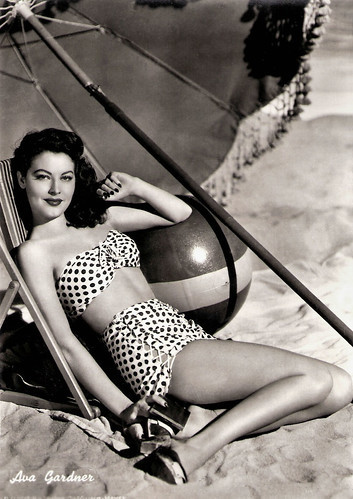
Italian postcard by Bromofoto, Milano, no. 224.
American actress Ava Gardner (1922-1990) was signed to a contract by MGM in 1941 and appeared mainly in small roles until she drew attention with her performance in The Killers (1946). She became one of Hollywood's leading stars and was considered one of the most beautiful women of her day.
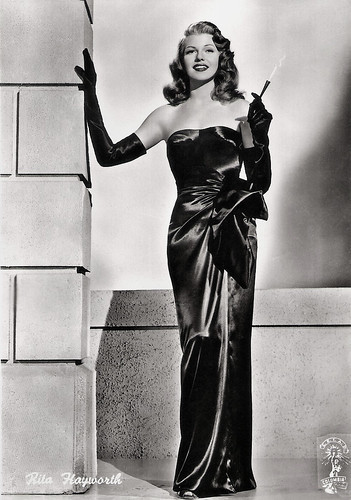
Italian postcard by Bromofoto, Milano, no. 237. Photo: Robert Coburn / Columbia Pictures. Rita Hayworth in Gilda (Charles Vidor, 1946).
Sultry Rita Hayworth (1918-1987) was an American dancer and actress whose beauty catapulted her to international stardom in the 1940s and 1950s. She hit stardom as an unfaithful wife opposite Cary Grant in Only Angels Have Wings (1939).

Italian postcard by Bromofoto, Milano, no. 250. Photo: RKO Radio Films. Dana Andrews in Deep Waters (Henry King, 1948).
American film actor Dana Andrews (1909-1992) was a major Hollywood star during the 1940s. He continued acting in less prestigious roles into the 1980s. He is remembered for his roles as a police detective-lieutenant in the Film Noir Laura (1944) and as war veteran Fred Derry in The Best Years of Our Lives (1946), the latter being the role for which he received the most critical praise.
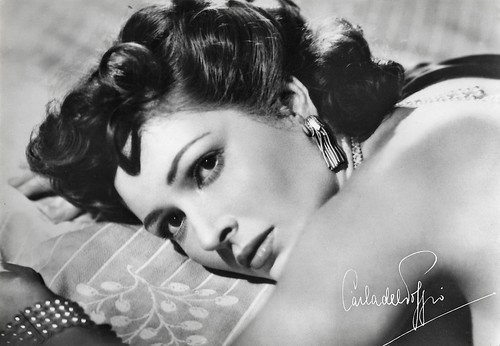
Italian postcard by Bromofoto, Milano, no. 312.
Italian actress Carla Del Poggio (1925-2010) was the female star of Federico Fellini’s bittersweet film debut Luci del varietà/Variety Lights (1950). In the 1940s and 1950s, she also starred in films by other famous directors such as Vittorio De Sica and her husband Alberto Lattuada.
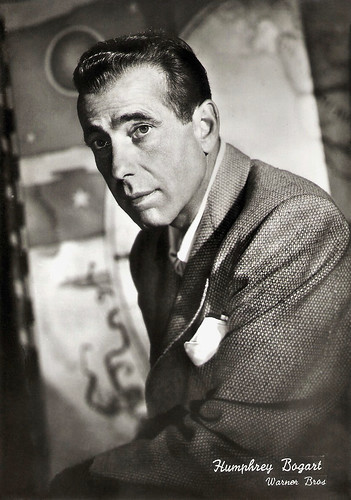
Italian postcard by Bromofoto, Milano, no. 317. Photo: Warner Bros.
Humphrey Bogart (1899-1957) is an icon of Hollywood cinema. His private detectives, Sam Spade in The Maltese Falcon (1941) and Phillip Marlowe in The Big Sleep (1946), became the models for detectives in other Film-Noirs.
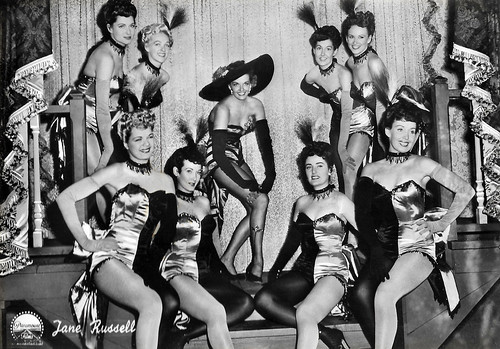
Italian postcard by Bromofoto, Milano, no. 378. Photo: Paramount Films. Jane Russell in Son of Paleface (Frank Tashlin, 1952).
American film actress Jane Russell (1921-2011) was one of Hollywood's leading sex symbols in the 1940s and 1950s.

Italian postcard by Bromofoto, Milano, no. 389. Photo: Dear Film.
Athletic Italian actor Raf Vallone (1916-2002) was an internationally acclaimed film star, known for his rugged good looks.
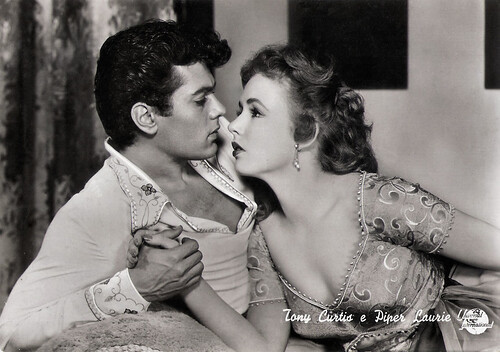
Italian postcard by Bromofoto, Milano, no. 400. Photo: Universal International. Tony Curtis and Piper Laurie in The Prince Who Was A Thief (Rudolph Maté, 1952).
American film actor Tony Curtis (1925-2010) played a variety of roles, from light comedy, such as the musician on the run from gangsters in Some Like It Hot (Billy Wilder, 1959), to serious dramatic roles, such as an escaped convict in The Defiant Ones (Stanley Kramer, 1958), which earned him a nomination for the Academy Award for Best Actor.
Piper Laurie (1932) is an American stage and screen actress known for her roles in the films The Hustler (1961), Carrie (1976), and Children of a Lesser God (1986), all of which brought her Oscar nominations.
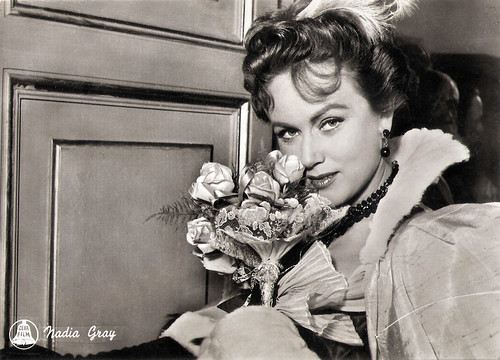
Italian postcard by Bromofoto, Milano, no. 467. Photo: Dear Film.
Romanian-born actress Nadia Gray (1923–1994) was an elegant and seductive star of European films of the 1950s and 1960s. Perhaps she is best known for her striptease scene in Fellini’s La Dolce Vita (1960).
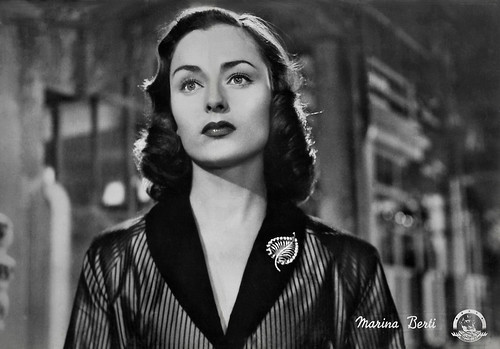
Italian postcard by Bromofoto, Milano, no. 471. Photo: Atlantic Film. Marina Berti in Febbre di vivere/Eager to Live (Claudio Gora, 1953). The film, Gora's second film as director after a rich career as an actor, was based on a play by Leopoldo Trieste called 'Cronaca'.
Italian actress Marina Berti (1924-2002) was a popular starlet of Italian films in the 1940s and early 1950s.
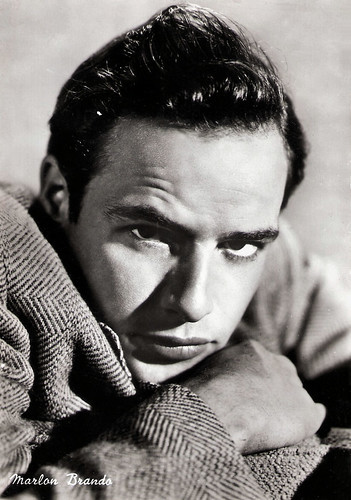
Italian postcard by Bromofoto, Milano, no. 565.
American film star Marlon Brando (1924-2004) was a cultural icon, most famous for his Oscar-winning performances as Terry Malloy in On the Waterfront (Elia Kazan, 1954) and Vito Corleone in The Godfather (1972).
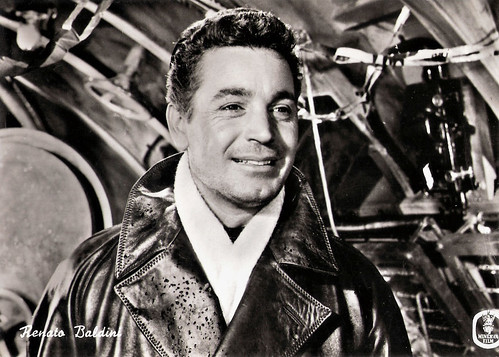
Italian postcard by Bromofoto, no. 706. Photo: Minerva Film. Renato Baldini in Oceano amaro/Bitter Ocean, the back of the card says. This title lacks in IMDb but it is probably the film La grande speranza/Torpedo Zone (Duilio Coletti, 1953), in which Baldini plays the lead as the commander of an Italian submarine during WWII. The film was based on true events.
Renato Baldini (1921-1995) was an Italian actor who appeared in 87 films between 1950 and 1983 and specialized in the genres 'en vogue' in Italian cinema.
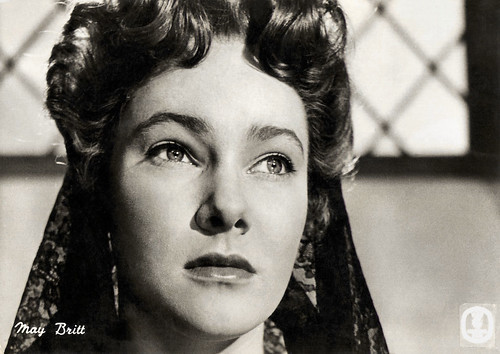
Italian postcard by Bromofoto, Milano, no. 716. May Britt in La nave delle donne maledette/The Ship of Damned Women (Raffaello Matarazzo, 1953).
Blonde, blue-eyed Swedish actress May Britt (1933) had a brief career as a film star in the 1950s, first in Italy and later in the United States. She retired from the screen after she married Sammy Davis, Jr. in 1960.
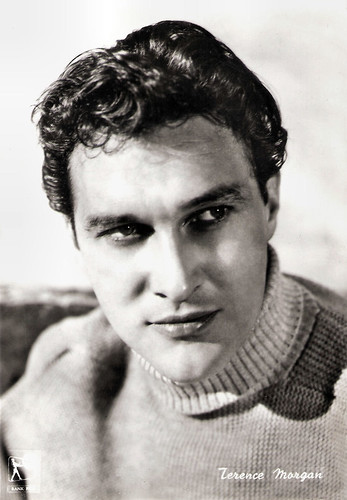
Italian postcard by Bromofoto, Milano, no. 1004. Photo: Rank Film. Terence Morgan in Dance Little Lady (Val Guest, 1954).
Tall, dark, and charming English actor Terence Morgan (1921-2005) played many attractive villains and criminals in British films. But he is probably best remembered for his starring role in the TV historical adventure series Sir Francis Drake (1961-1962), about the first Englishman to sail around the world. After this success, parts started to dry up as Morgan was no longer seen as ‘the bad guy’.
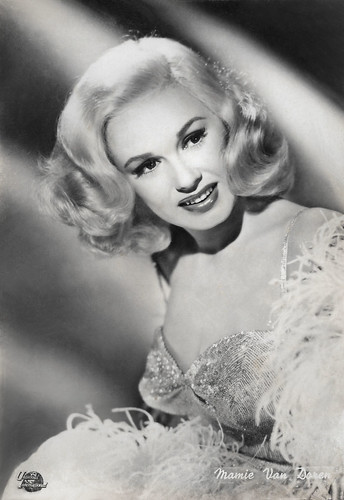
Italian postcard by Bromofoto, Milano, no. 1088. Photo: Universal-International.
Voluptuous American actress Mamie Van Doren (1931) was a sex symbol of the 1950s and 1960s. Van Doren starred in several exploitation films such as Untamed Youth (1957), loaded with rock 'n' roll and juvenile delinquency. Her onscreen wardrobe usually consisted of tight sweaters, low-cut blouses, form-fitting dresses, and daring swimsuits.
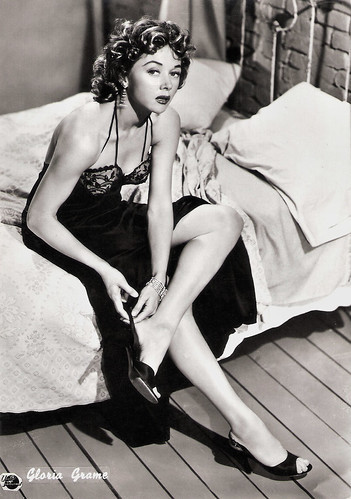
Italian postcard by Bromofoto, Milano, no. 1190. Photo: Universal-International. Gloria Grahame in Naked Alibi (Jerry Hopper, 1954).
American stage, film, television actress, and singer Gloria Grahame (1923-1981) was often cast in Film Noirs as a tarnished beauty with an irresistible sexual allure. She received an Oscar for Best Supporting Actress nomination for Crossfire (1947), and would later win the award for The Bad and the Beautiful (1952).
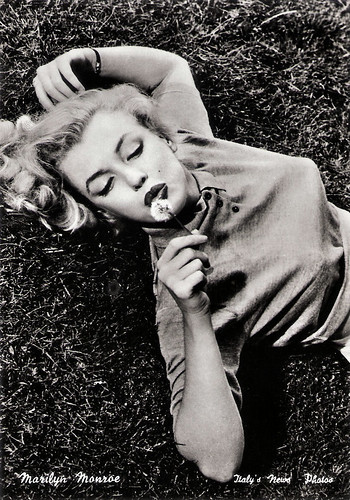
Italian postcard by Bromofoto, Milano, no. 1195. Caption: Italy's News Photos.
By 1953, Marilyn Monroe (1926-1962) was one of the most marketable Hollywood stars, with leading roles in three films: the Noir Niagara, which focused on her sex appeal, and the comedies Gentlemen Prefer Blondes and How to Marry a Millionaire, which established her star image as a 'dumb blonde'.
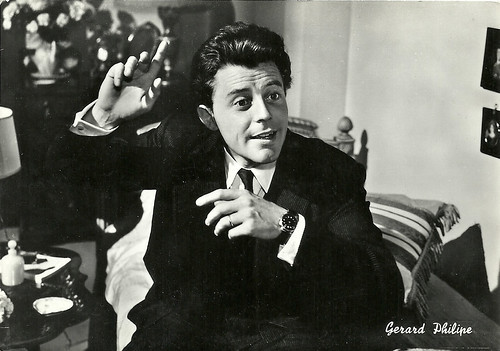
Italian postcard by Bromofoto, Milano, no. 1197. Gérard Philipe in Monsieur Ripois/Lovers, Happy Lovers! (René Clément, 1954).
The legendary idol of the French cinema Gérard Philipe (1922–1959) was adored for his good looks, but he was also a very talented actor. He played roles as diverse as Faust and Modigliani and he was sought out by France's preeminent directors for his versatility and professionalism.
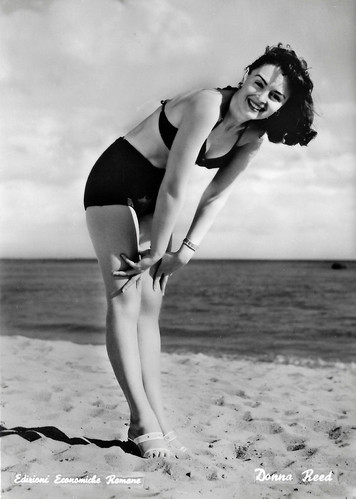
Italian postcard by Bromofoto, Milano, no. 1213. Photo: Edizioni Economiche Romana.
Donna Reed (1921-1986) was an American film, television actress, and producer. Her career spanned more than 40 years, with performances in more than 40 films. She is well known for her role as Mary Hatch Bailey in It's a Wonderful Life (Frank Capra, 1946). She received the Oscar for Best Supporting Actress for her role as Lorene Burke in the war drama From Here to Eternity (Fred Zinnemann, 1953).
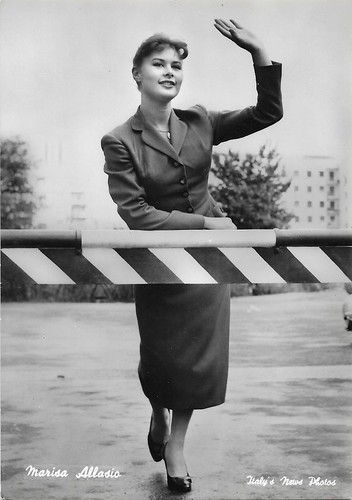
Italian postcard by Bromofoto, Milano, no. 1228. Italy's News Photos.
Italian actress Marisa Allasio (born 1934) was a glamorous starlet who appeared in nearly twenty pictures in the 1950s. She was nicknamed ‘The Italian Jayne Mansfield’. In 1958 her career stopped abruptly when she married and became a countess.
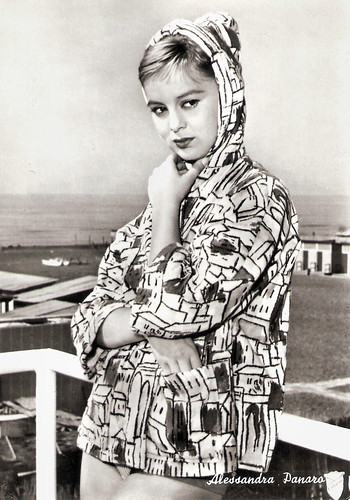
Italian postcard by Bromofoto, Milano, no. 1310.
Alessandra Panaro (1939-2019) was an Italian film actress of the late 1950s and early 1960s. She is best known for Luchino Visconti's crime drama Rocco e i suoi fratelli/Rocco and His Brothers (1960).
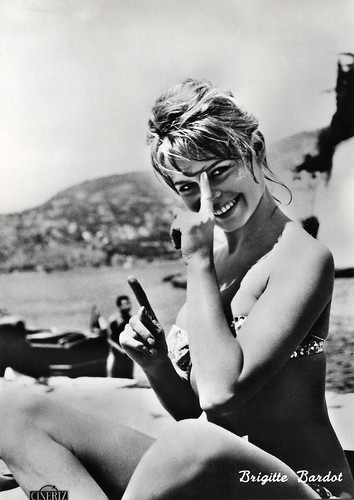
Italian postcard by Bromofoto, Milano, no. 1435. Photo: Cineriz.
Beautiful French actress Brigitte Bardot (1934) was the sex kitten of the European film industry. BB starred in 48 films, performed in numerous musical shows, and recorded 80 songs. After her retirement in 1973, she established herself as an animal rights activist and made vegetarianism sexy.
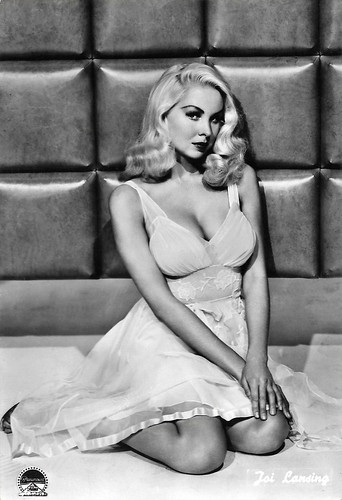
Italian postcard by Bromofoto, Milano, no. 1618. Photo: Paramount.
Joi Lansing (1929-1972) was a voluptuous, peroxide-blonde American model, actress, and nightclub singer. She was noted for her pin-up photos and roles in B-movies often cast in roles similar to those played by Jayne Mansfield and Mamie Van Doren. Remarkable was her prominent role in the opening tracking shot in Orson Welles' classic Touch of Evil (1958).
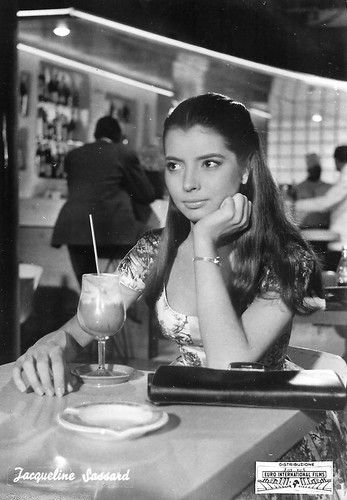
Italian postcard by Bromofoto, Milano, no. 1724. Photo: Distr. Euro International Films. Jacqueline Sassard in the Franco-Italian coproduction Le donne sono deboli/Faibles femmes (Mchel Boisrond, 1959).
Charming and beautiful Jacqueline Sassard (1940) had a short but successful career in the European cinema of the late 1950s and 1960s.
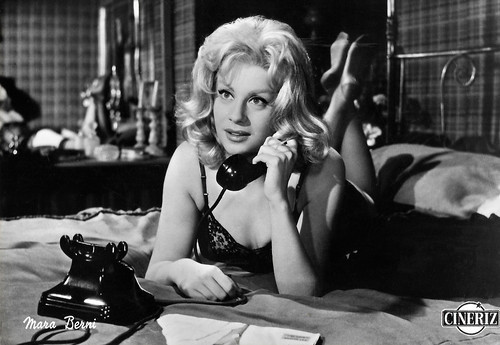
Italian postcard by Bromofoto, Milano, no. 1731. Photo: Cineriz. Mara Berni in Il vigile/The Traffic Policeman (Luigi Zampa, 1960).
Blonde, shapely, with fresh and sensual beauty, Mara Berni (1932) took part in about forty films made between the 1950s and 1960s, mostly in the comical genre, alongside big names such as Alberto Sordi and Totò.
And please, check out our Bromofoto album on Flickr.

Italian postcard by Bromofoto, Milano, no. 224.
American actress Ava Gardner (1922-1990) was signed to a contract by MGM in 1941 and appeared mainly in small roles until she drew attention with her performance in The Killers (1946). She became one of Hollywood's leading stars and was considered one of the most beautiful women of her day.

Italian postcard by Bromofoto, Milano, no. 237. Photo: Robert Coburn / Columbia Pictures. Rita Hayworth in Gilda (Charles Vidor, 1946).
Sultry Rita Hayworth (1918-1987) was an American dancer and actress whose beauty catapulted her to international stardom in the 1940s and 1950s. She hit stardom as an unfaithful wife opposite Cary Grant in Only Angels Have Wings (1939).

Italian postcard by Bromofoto, Milano, no. 250. Photo: RKO Radio Films. Dana Andrews in Deep Waters (Henry King, 1948).
American film actor Dana Andrews (1909-1992) was a major Hollywood star during the 1940s. He continued acting in less prestigious roles into the 1980s. He is remembered for his roles as a police detective-lieutenant in the Film Noir Laura (1944) and as war veteran Fred Derry in The Best Years of Our Lives (1946), the latter being the role for which he received the most critical praise.

Italian postcard by Bromofoto, Milano, no. 312.
Italian actress Carla Del Poggio (1925-2010) was the female star of Federico Fellini’s bittersweet film debut Luci del varietà/Variety Lights (1950). In the 1940s and 1950s, she also starred in films by other famous directors such as Vittorio De Sica and her husband Alberto Lattuada.

Italian postcard by Bromofoto, Milano, no. 317. Photo: Warner Bros.
Humphrey Bogart (1899-1957) is an icon of Hollywood cinema. His private detectives, Sam Spade in The Maltese Falcon (1941) and Phillip Marlowe in The Big Sleep (1946), became the models for detectives in other Film-Noirs.

Italian postcard by Bromofoto, Milano, no. 378. Photo: Paramount Films. Jane Russell in Son of Paleface (Frank Tashlin, 1952).
American film actress Jane Russell (1921-2011) was one of Hollywood's leading sex symbols in the 1940s and 1950s.

Italian postcard by Bromofoto, Milano, no. 389. Photo: Dear Film.
Athletic Italian actor Raf Vallone (1916-2002) was an internationally acclaimed film star, known for his rugged good looks.

Italian postcard by Bromofoto, Milano, no. 400. Photo: Universal International. Tony Curtis and Piper Laurie in The Prince Who Was A Thief (Rudolph Maté, 1952).
American film actor Tony Curtis (1925-2010) played a variety of roles, from light comedy, such as the musician on the run from gangsters in Some Like It Hot (Billy Wilder, 1959), to serious dramatic roles, such as an escaped convict in The Defiant Ones (Stanley Kramer, 1958), which earned him a nomination for the Academy Award for Best Actor.
Piper Laurie (1932) is an American stage and screen actress known for her roles in the films The Hustler (1961), Carrie (1976), and Children of a Lesser God (1986), all of which brought her Oscar nominations.

Italian postcard by Bromofoto, Milano, no. 467. Photo: Dear Film.
Romanian-born actress Nadia Gray (1923–1994) was an elegant and seductive star of European films of the 1950s and 1960s. Perhaps she is best known for her striptease scene in Fellini’s La Dolce Vita (1960).

Italian postcard by Bromofoto, Milano, no. 471. Photo: Atlantic Film. Marina Berti in Febbre di vivere/Eager to Live (Claudio Gora, 1953). The film, Gora's second film as director after a rich career as an actor, was based on a play by Leopoldo Trieste called 'Cronaca'.
Italian actress Marina Berti (1924-2002) was a popular starlet of Italian films in the 1940s and early 1950s.

Italian postcard by Bromofoto, Milano, no. 565.
American film star Marlon Brando (1924-2004) was a cultural icon, most famous for his Oscar-winning performances as Terry Malloy in On the Waterfront (Elia Kazan, 1954) and Vito Corleone in The Godfather (1972).

Italian postcard by Bromofoto, no. 706. Photo: Minerva Film. Renato Baldini in Oceano amaro/Bitter Ocean, the back of the card says. This title lacks in IMDb but it is probably the film La grande speranza/Torpedo Zone (Duilio Coletti, 1953), in which Baldini plays the lead as the commander of an Italian submarine during WWII. The film was based on true events.
Renato Baldini (1921-1995) was an Italian actor who appeared in 87 films between 1950 and 1983 and specialized in the genres 'en vogue' in Italian cinema.

Italian postcard by Bromofoto, Milano, no. 716. May Britt in La nave delle donne maledette/The Ship of Damned Women (Raffaello Matarazzo, 1953).
Blonde, blue-eyed Swedish actress May Britt (1933) had a brief career as a film star in the 1950s, first in Italy and later in the United States. She retired from the screen after she married Sammy Davis, Jr. in 1960.

Italian postcard by Bromofoto, Milano, no. 1004. Photo: Rank Film. Terence Morgan in Dance Little Lady (Val Guest, 1954).
Tall, dark, and charming English actor Terence Morgan (1921-2005) played many attractive villains and criminals in British films. But he is probably best remembered for his starring role in the TV historical adventure series Sir Francis Drake (1961-1962), about the first Englishman to sail around the world. After this success, parts started to dry up as Morgan was no longer seen as ‘the bad guy’.

Italian postcard by Bromofoto, Milano, no. 1088. Photo: Universal-International.
Voluptuous American actress Mamie Van Doren (1931) was a sex symbol of the 1950s and 1960s. Van Doren starred in several exploitation films such as Untamed Youth (1957), loaded with rock 'n' roll and juvenile delinquency. Her onscreen wardrobe usually consisted of tight sweaters, low-cut blouses, form-fitting dresses, and daring swimsuits.

Italian postcard by Bromofoto, Milano, no. 1190. Photo: Universal-International. Gloria Grahame in Naked Alibi (Jerry Hopper, 1954).
American stage, film, television actress, and singer Gloria Grahame (1923-1981) was often cast in Film Noirs as a tarnished beauty with an irresistible sexual allure. She received an Oscar for Best Supporting Actress nomination for Crossfire (1947), and would later win the award for The Bad and the Beautiful (1952).

Italian postcard by Bromofoto, Milano, no. 1195. Caption: Italy's News Photos.
By 1953, Marilyn Monroe (1926-1962) was one of the most marketable Hollywood stars, with leading roles in three films: the Noir Niagara, which focused on her sex appeal, and the comedies Gentlemen Prefer Blondes and How to Marry a Millionaire, which established her star image as a 'dumb blonde'.

Italian postcard by Bromofoto, Milano, no. 1197. Gérard Philipe in Monsieur Ripois/Lovers, Happy Lovers! (René Clément, 1954).
The legendary idol of the French cinema Gérard Philipe (1922–1959) was adored for his good looks, but he was also a very talented actor. He played roles as diverse as Faust and Modigliani and he was sought out by France's preeminent directors for his versatility and professionalism.

Italian postcard by Bromofoto, Milano, no. 1213. Photo: Edizioni Economiche Romana.
Donna Reed (1921-1986) was an American film, television actress, and producer. Her career spanned more than 40 years, with performances in more than 40 films. She is well known for her role as Mary Hatch Bailey in It's a Wonderful Life (Frank Capra, 1946). She received the Oscar for Best Supporting Actress for her role as Lorene Burke in the war drama From Here to Eternity (Fred Zinnemann, 1953).

Italian postcard by Bromofoto, Milano, no. 1228. Italy's News Photos.
Italian actress Marisa Allasio (born 1934) was a glamorous starlet who appeared in nearly twenty pictures in the 1950s. She was nicknamed ‘The Italian Jayne Mansfield’. In 1958 her career stopped abruptly when she married and became a countess.

Italian postcard by Bromofoto, Milano, no. 1310.
Alessandra Panaro (1939-2019) was an Italian film actress of the late 1950s and early 1960s. She is best known for Luchino Visconti's crime drama Rocco e i suoi fratelli/Rocco and His Brothers (1960).

Italian postcard by Bromofoto, Milano, no. 1435. Photo: Cineriz.
Beautiful French actress Brigitte Bardot (1934) was the sex kitten of the European film industry. BB starred in 48 films, performed in numerous musical shows, and recorded 80 songs. After her retirement in 1973, she established herself as an animal rights activist and made vegetarianism sexy.

Italian postcard by Bromofoto, Milano, no. 1618. Photo: Paramount.
Joi Lansing (1929-1972) was a voluptuous, peroxide-blonde American model, actress, and nightclub singer. She was noted for her pin-up photos and roles in B-movies often cast in roles similar to those played by Jayne Mansfield and Mamie Van Doren. Remarkable was her prominent role in the opening tracking shot in Orson Welles' classic Touch of Evil (1958).

Italian postcard by Bromofoto, Milano, no. 1724. Photo: Distr. Euro International Films. Jacqueline Sassard in the Franco-Italian coproduction Le donne sono deboli/Faibles femmes (Mchel Boisrond, 1959).
Charming and beautiful Jacqueline Sassard (1940) had a short but successful career in the European cinema of the late 1950s and 1960s.

Italian postcard by Bromofoto, Milano, no. 1731. Photo: Cineriz. Mara Berni in Il vigile/The Traffic Policeman (Luigi Zampa, 1960).
Blonde, shapely, with fresh and sensual beauty, Mara Berni (1932) took part in about forty films made between the 1950s and 1960s, mostly in the comical genre, alongside big names such as Alberto Sordi and Totò.
And please, check out our Bromofoto album on Flickr.
Published on August 06, 2021 22:00
August 5, 2021
Val Kilmer
Val Kilmer (1959) is an American actor, known for such blockbusters as Top Gun (1986), Batman Forever (1995) and Heat (1995). His chameleon-like ability to plunge fully and breathlessly into his characters catapulted him to fame in the mid-1980s but his reputation to be a troublesome actor and a series of disappointing films held him back from megastardom.
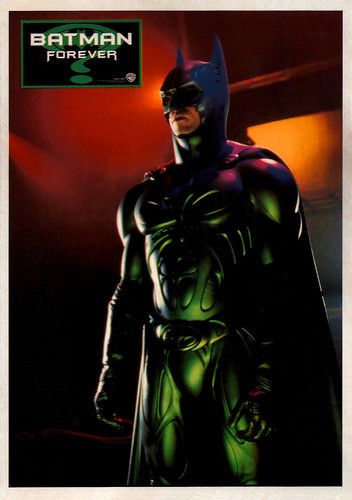
French postcard by Editions Mercuri, no. 1620. Photo: Warner Bros. Val Kilmer in Batman Forever (Joel Schumacher, 1995).
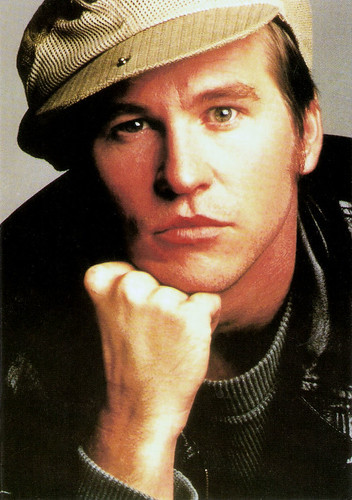
British postcard by Heroes Publishing Ltd., London, no. SPC 2895.
Iceman
Val Edward Kilmer was born in Los Angeles, in 1959. He is the son of Gladys Swanette (Ekstadt) and Eugene Dorris Kilmer, who was a real estate developer and aerospace equipment distributor. His family is a textbook example of mixed blood. He has Scottish, Swedish, Irish, Mongolian, and Cherokee blood in his veins, among others.
Val grew up in the San Fernando Valley. His parents divorced when he was 9 years old. His first auditions were for commercials at 13 years old. When he was 17 years old, his younger brother Wesley who was an epileptic, drowned in a jacuzzi at age 15. Kilmer learned acting at the famous Juilliard Drama School in New York. He was the youngest student in history to be admitted to Juilliard.
In 1983 he played his first television role and a year later he made his film debut with the lead role as blond rock idol Nick Rivers in Top Secret! (Jim Abrahams, David Zucker, 1984), a spoof of Elvis films and WWII spy movies. Andrea LeVasseur at AllMovie : "An absurd role which Kilmer plays with complete sincerity, it reveals genuine musical talent and Kilmer achieves complete credibility as a rock star."
He had his big break in the role of Tom 'Iceman' Kazanski in Top Gun (Tony Scott, 1986) starring Tom Cruise . Top Gun grossed a total of $344,700,000 worldwide and made Kilmer a major star.
He gave a believable performance as Jim Morrison in Oliver Stone's The Doors (1991). He had spent close to a year before production dressing in Morrison-like clothes and had spent time at Morrison's old hangouts along the Sunset Strip. Kilmer did his own singing during the concert pieces and a number of his Doors songs were used on the soundtrack, sans dubbing.
Two years later, Kilmer played two more American legends, the spirit of Elvis Presley in True Romance (Tony Scott, 1993), which was written by Quentin Tarantino, and gunslinger Doc Holliday in the Western Tombstone (George P. Cosmatos, 1993).
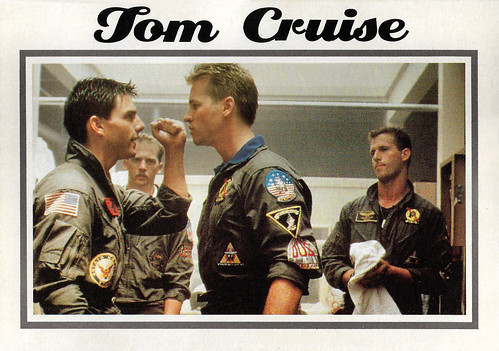
British postcard by New-Line, no. 193. Photo: Paramount. Tom Cruise , Val Kilmer, Rick Rossovich, and Anthony Edwards in Top Gun (Tony Scott, 1986).
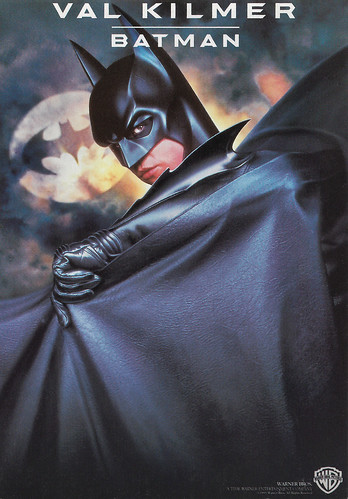
Belgian postcard by Boomerang Free Cards. Photo: Warner Bros. Val Kilmer in Batman Forever (Joel Schumacher, 1995).
Batman
Val Kilmer took over the role of Batman/Bruce Wayne from Michael Keaton in Batman Forever (Joel Schumacher, 1995). Batman Forever was a success at the box office, despite receiving mixed reviews from critics. Although he enjoyed playing Batman his working relationship with director Joel Schumacher was poor. Kilmer openly refused to repeat the Bruce Wayne role for Batman and Robin (Joel Schumacher, 1997), and he was succeeded by George Clooney.
Due to his persistent need for an on-set dialogue with his directors, Kilmer had clashed earlier with Michael Apted on the set of Thunderheart (1992) and later infuriated director John Frankenheimer on the set of The Island of Dr. Moreau (1996). However, others consider him a devoted, hard-working professional. Warwick Davis, Kilmer's co-star in Willow (Ron Howard, 1988), says he has very fond memories of working with Kilmer, stating that Kilmer had a great sense of humor and was very dedicated to the job.
In addition to acting, Kilmer is also engaged in writing. In 1981 he wrote the play 'How It All Began', performed at the New York Shakespeare Festival. Later in the 1980s, he wrote a poetry collection, 'My Eden after burns'. Kilmer also acted on the stage. He played Hamlet at the 1988 Colorado Shakespeare Festival. In 2004 he played Moses in a musical and in 2005 he starred in London in David Mamet's play 'The Postman Always Rings Twice'.
His other notable films include Heat (Michael Mann, 1995) with Robert De Niro and Al Pacino , the disappointing The Saint (Philip Noyce, 1997), and the action-comedy Kiss Kiss Bang Bang (Shane Black, 2005) with Robert Downey Jr. Another disappointment was the historical epic Alexander (Oliver Stone, 2004) in which he played the father of Alexander, King Philip, opposite Colin Farrell as Alexander.
The Disney studios Sci-Fi-action thriller Deja Vu (Tony Scott, 2006) teamed Kilmer and Denzel Washington as feds who travel back in time to stop a terrorist's (Jim Caviezel) attempt to blow up a ferry. He also appeared in Werner Herzog's semi-sequel Bad Lieutenant: Port of Call - New Orleans (2009), and Francis Ford Coppola's horror opus Twixt (2011), with Bruce Dern and Elle Fanning.
Kilmer is a longtime board member of the New Mexico State Film Commission, which tries to persuade Los Angeles - based filmmakers and studios to film on location in New Mexico. From 1988 to 1996, Val Kilmer was married to British actress Joanne Whalley, whom he met while filming Willow (Ron Howard, 1988). They have two children: a daughter, Mercedes (1992), and a son, Jack (1995).
Kilmer has gone through a battle with throat cancer. A procedure on his trachea has reduced his voice to a rasp and rendered him short of breath. He underwent chemotherapy and two tracheotomies. In 2020, Kilmer reported that he had been cancer-free for four years and that he uses a feeding tube to feed himself because he can no longer eat. He continues to act in films and upcoming is the Top Gun sequel Top Gun: Maverick (Joseph Kosinski, 2021) in which Kilmer reprises his role as LT Tom 'Iceman' Kazanski.
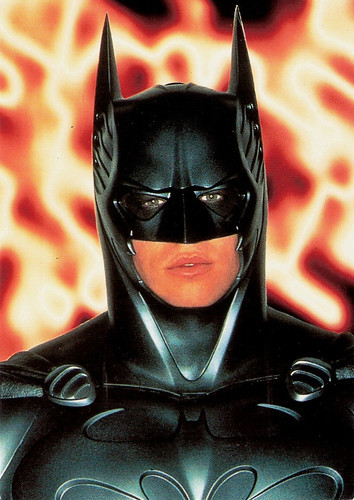
British postcard by Slow Dazzle Worldwide, no 10 in a series of 16. Val Kilmer in Batman Forever (Joel Schumacher, 1995).
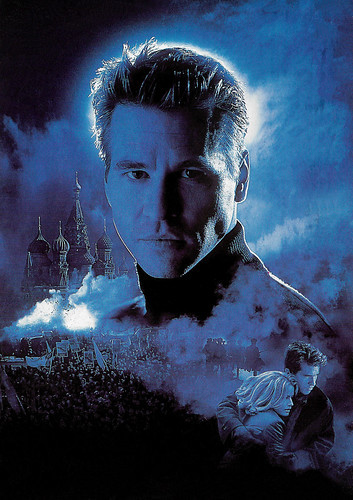
British postcard by Boomerang Media. Photo: Paramount. Val Kilmer in The Saint (Philip Noyce, 1997).
Sources: Andrea LeVasseur (AllMovie), (IMDb), Wikipedia (Dutch and English), and .

French postcard by Editions Mercuri, no. 1620. Photo: Warner Bros. Val Kilmer in Batman Forever (Joel Schumacher, 1995).

British postcard by Heroes Publishing Ltd., London, no. SPC 2895.
Iceman
Val Edward Kilmer was born in Los Angeles, in 1959. He is the son of Gladys Swanette (Ekstadt) and Eugene Dorris Kilmer, who was a real estate developer and aerospace equipment distributor. His family is a textbook example of mixed blood. He has Scottish, Swedish, Irish, Mongolian, and Cherokee blood in his veins, among others.
Val grew up in the San Fernando Valley. His parents divorced when he was 9 years old. His first auditions were for commercials at 13 years old. When he was 17 years old, his younger brother Wesley who was an epileptic, drowned in a jacuzzi at age 15. Kilmer learned acting at the famous Juilliard Drama School in New York. He was the youngest student in history to be admitted to Juilliard.
In 1983 he played his first television role and a year later he made his film debut with the lead role as blond rock idol Nick Rivers in Top Secret! (Jim Abrahams, David Zucker, 1984), a spoof of Elvis films and WWII spy movies. Andrea LeVasseur at AllMovie : "An absurd role which Kilmer plays with complete sincerity, it reveals genuine musical talent and Kilmer achieves complete credibility as a rock star."
He had his big break in the role of Tom 'Iceman' Kazanski in Top Gun (Tony Scott, 1986) starring Tom Cruise . Top Gun grossed a total of $344,700,000 worldwide and made Kilmer a major star.
He gave a believable performance as Jim Morrison in Oliver Stone's The Doors (1991). He had spent close to a year before production dressing in Morrison-like clothes and had spent time at Morrison's old hangouts along the Sunset Strip. Kilmer did his own singing during the concert pieces and a number of his Doors songs were used on the soundtrack, sans dubbing.
Two years later, Kilmer played two more American legends, the spirit of Elvis Presley in True Romance (Tony Scott, 1993), which was written by Quentin Tarantino, and gunslinger Doc Holliday in the Western Tombstone (George P. Cosmatos, 1993).

British postcard by New-Line, no. 193. Photo: Paramount. Tom Cruise , Val Kilmer, Rick Rossovich, and Anthony Edwards in Top Gun (Tony Scott, 1986).

Belgian postcard by Boomerang Free Cards. Photo: Warner Bros. Val Kilmer in Batman Forever (Joel Schumacher, 1995).
Batman
Val Kilmer took over the role of Batman/Bruce Wayne from Michael Keaton in Batman Forever (Joel Schumacher, 1995). Batman Forever was a success at the box office, despite receiving mixed reviews from critics. Although he enjoyed playing Batman his working relationship with director Joel Schumacher was poor. Kilmer openly refused to repeat the Bruce Wayne role for Batman and Robin (Joel Schumacher, 1997), and he was succeeded by George Clooney.
Due to his persistent need for an on-set dialogue with his directors, Kilmer had clashed earlier with Michael Apted on the set of Thunderheart (1992) and later infuriated director John Frankenheimer on the set of The Island of Dr. Moreau (1996). However, others consider him a devoted, hard-working professional. Warwick Davis, Kilmer's co-star in Willow (Ron Howard, 1988), says he has very fond memories of working with Kilmer, stating that Kilmer had a great sense of humor and was very dedicated to the job.
In addition to acting, Kilmer is also engaged in writing. In 1981 he wrote the play 'How It All Began', performed at the New York Shakespeare Festival. Later in the 1980s, he wrote a poetry collection, 'My Eden after burns'. Kilmer also acted on the stage. He played Hamlet at the 1988 Colorado Shakespeare Festival. In 2004 he played Moses in a musical and in 2005 he starred in London in David Mamet's play 'The Postman Always Rings Twice'.
His other notable films include Heat (Michael Mann, 1995) with Robert De Niro and Al Pacino , the disappointing The Saint (Philip Noyce, 1997), and the action-comedy Kiss Kiss Bang Bang (Shane Black, 2005) with Robert Downey Jr. Another disappointment was the historical epic Alexander (Oliver Stone, 2004) in which he played the father of Alexander, King Philip, opposite Colin Farrell as Alexander.
The Disney studios Sci-Fi-action thriller Deja Vu (Tony Scott, 2006) teamed Kilmer and Denzel Washington as feds who travel back in time to stop a terrorist's (Jim Caviezel) attempt to blow up a ferry. He also appeared in Werner Herzog's semi-sequel Bad Lieutenant: Port of Call - New Orleans (2009), and Francis Ford Coppola's horror opus Twixt (2011), with Bruce Dern and Elle Fanning.
Kilmer is a longtime board member of the New Mexico State Film Commission, which tries to persuade Los Angeles - based filmmakers and studios to film on location in New Mexico. From 1988 to 1996, Val Kilmer was married to British actress Joanne Whalley, whom he met while filming Willow (Ron Howard, 1988). They have two children: a daughter, Mercedes (1992), and a son, Jack (1995).
Kilmer has gone through a battle with throat cancer. A procedure on his trachea has reduced his voice to a rasp and rendered him short of breath. He underwent chemotherapy and two tracheotomies. In 2020, Kilmer reported that he had been cancer-free for four years and that he uses a feeding tube to feed himself because he can no longer eat. He continues to act in films and upcoming is the Top Gun sequel Top Gun: Maverick (Joseph Kosinski, 2021) in which Kilmer reprises his role as LT Tom 'Iceman' Kazanski.

British postcard by Slow Dazzle Worldwide, no 10 in a series of 16. Val Kilmer in Batman Forever (Joel Schumacher, 1995).

British postcard by Boomerang Media. Photo: Paramount. Val Kilmer in The Saint (Philip Noyce, 1997).
Sources: Andrea LeVasseur (AllMovie), (IMDb), Wikipedia (Dutch and English), and .
Published on August 05, 2021 22:00
August 4, 2021
Benita Hume
Brunette Benita Hume (1907-1967) was an English theatre and film actress. She appeared in 44 films between 1925 and 1955, from the silent film era to sound film. She had a prolific even if a short-lived career as the leading lady in Hollywood cinema.
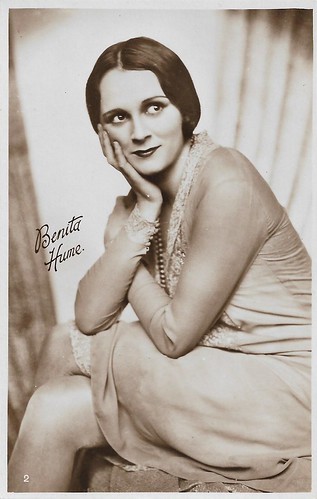
British Real Photograph postcard by Sarony, no. 2 of a fifth series of 25 Cinema Stars, issued with Sarony Cigarettes.
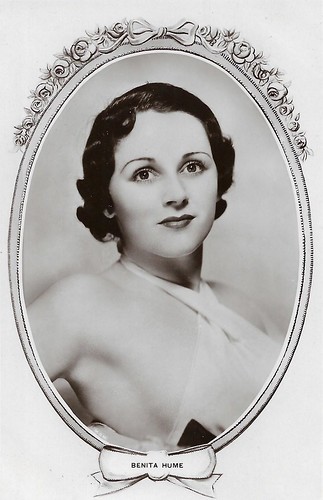
British postcard in the Cameo Series, London, no. K.32.
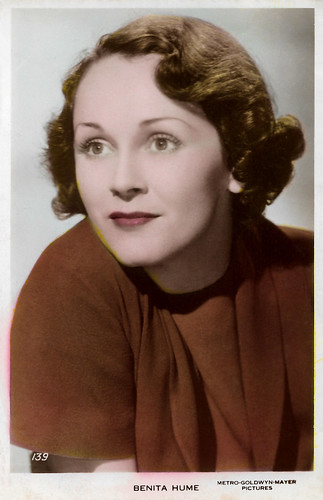
British postcard by Art Photo, no. 139. Photo: Metro-Goldwyn-Mayer.
Overheated leaders of the US and United Europe
Benita Hume was born as Benita Humm in Beckenham, London, England, in 1907. She was the daughter of Henry Josiah Humm and Jane Humm née Duff.
Hume started out as a pianist but pursued acting because she wanted "excitement", according to IMDb . She did the RADA theatre academy and the seventeen-year-old started to act on stage in 1924.
From 1925 she played small parts in British cinema e.g. in Alfred Hitchcock 's Easy Virtue (1927), and she had her first major part in the spy drama Second to None (Jack Raymond, 1927).
She was one of the Sanger sisters in The Constant Nymph (Adrian Brunel, 1928), starring Ivor Novello and Mabel Poulton, and had the female lead in the period piece Balaclava (Maurice Elvey, Milton Rosmer, 1928), set during the Crimean War. Elvey shot the silent version, but Rosmer reshot much to turn it into a talkie.
In A South Sea Bubble (T. Hayes Hunter, 1928), Hume was paired again with Ivor Novello , but now as the leading lady. Again Brunel directed her in A Light Woman (Adrian Brunel 1928), in which she was the star, while she was the title character in The Lady of the Lake (James A. FitzPatrick, 1928).
In the Science-Fiction film High Treason (Maurice Elvey, 1929), shot both as silent and sound version, pacifist women led by Hume's character and her father unite to prevent overheated leaders of the US and United Europe (it is SF!) and war-mongering financiers and agitators from engineering a second world war.
Hume next played in two more crime films: The Clue of the New Pin (Athur Maude, 1929) and the German-British co-production Der Würger/The Wrecker (Géza von Bolváry, 1929), based on an Edgar Wallace novel.
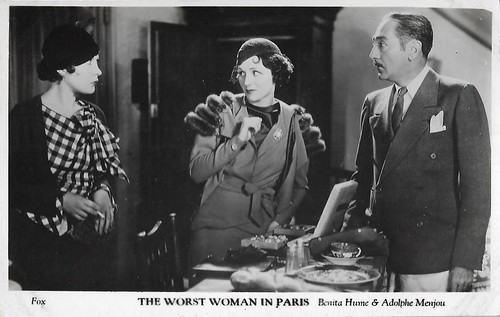
British postcard by Film Weekly. Photo: Fox Film. Benita Hume and Adolphe Menjou in the American pre-Code movie The Worst Woman in Paris? (Monta Bell, 1933).
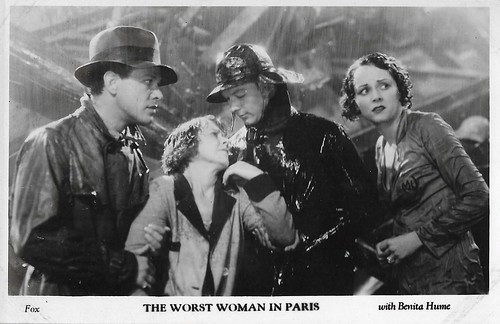
British postcard by Film Weekly. Photo: Fox Film. Benita Hume in The Worst Woman in Paris? (Monta Bell, 1933).
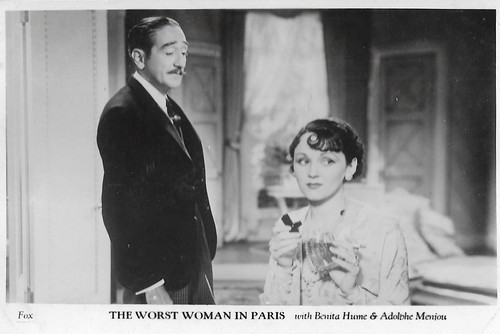
British postcard by Film Weekly. Photo: Fox Film. Benita Hume and Adolphe Menjou in the American pre-Code movie The Worst Woman in Paris? (Monta Bell, 1933).
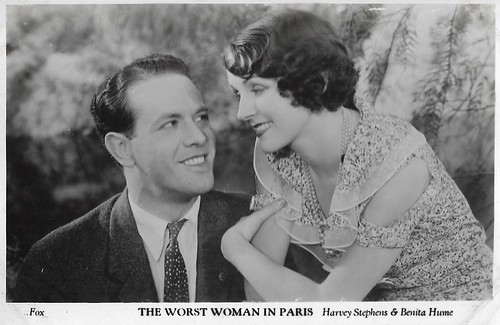
British postcard by Film Weekly. Photo: Fox Film. Benita Hume and Harvey Stephens in the American pre-Code movie The Worst Woman in Paris? (Monta Bell, 1933).
A series of well-coiffed English ladies in RKO and MGM films
In 1930, Benita Hume won the female leading role in Ivor Novello 's hit play 'Symphony in Two Flats'. She accompanied Novello when he took the play to the U.S.A. and it became her successful Broadway debut. In the same year, she acted in the UK film version of the play, Symphony in Two Flats (Gareth Gundrey, 1930).
She continued to act in various British crime films and dramas by Maurice Elvey and others. In 1931 she would divorce her first husband, Eric Otto Siepmann, whom she had married in 1926 when she was 19.
After one Warner production shot at their UK studios in 1932, Hume also started a prolific even if short-lived career as the leading lady in Hollywood cinema, though she never became a huge star. IMDb : "she played a series of well-coiffed English ladies in RKO and MGM films". In fact, Hume acted in 11 American films between 1932 and 1933. After the impostors' story Diamond Cut Diamond (Maurice Elvey, Fred Niblo, 1932), with Adolphe Menjou , she acted in such films as the press drama Clear All Wires! (George Hill, 1933) with Lee Tracy, and The Worst Woman in Paris? (Monta Bell, 1933), which was her last American film.
From the second half of 1934, Hume acted in British films again. For some films, she was occasionally called to the US again, e.g. for Tarzan Escapes (Richard Thorpe, 1936) starring Johnny Weissmuller , though not as the female star of the films anymore.
In 1938 Hume quit film acting altogether, though she continued with radio and TV work. In 1938 Benita Hume married British actor Ronald Colman , with whom she appeared on the Jack Benny radio show. They were supposed to be Jack's next-door neighbours, and were usually referred to as "Ronnie and Benita". Their episodes usually dealt with either Jack embarrassing the couple in public or trying to weasel his way into a Colman party at their house.
Hume and Colman also starred in the radio show 'The Halls of Ivy' (1950-1952) and the TV version The Halls of Ivy (1954-1955). The couple co-owned a resort in California and had one daughter, Juliet (1944). After Colman's death in 1958, Hume remarried with British actor George Sanders in 1959. They remained together till her death. Benita Hume died in 1967 at Egerton, Kent, UK, due to bone cancer. She was 61. Hume was cremated and her ashes were scattered at the Charing Crematorium, aka Kent County Crematorium.
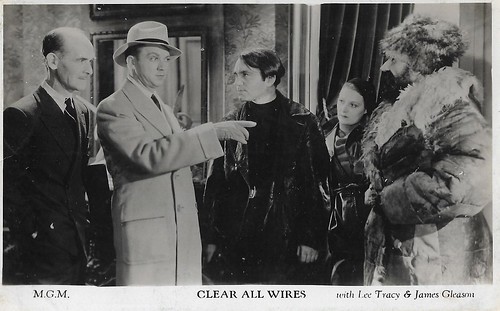
British postcard by Film Weekly. Photo: MGM. Lee Tracy and Benita Hume in the American pre-Code comedy Clear All Wires! (George Hill, 1933). Left of Tracy stands James Gleason.
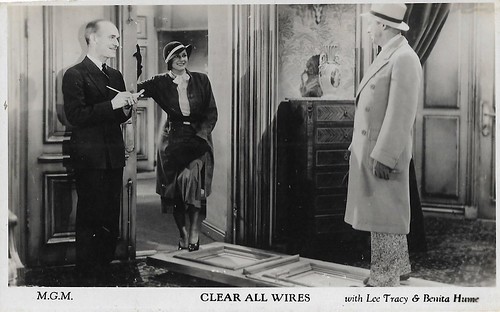
British postcard by Film Weekly. Photo: MGM. Lee Tracy and Benita Hume in the American pre-Code comedy Clear All Wires! (George Hill, 1933). Left stands James Gleason.
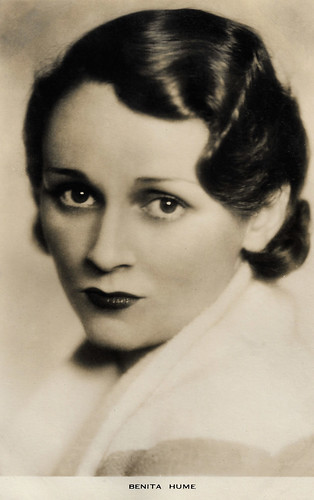
British postcard by Film Weekly, London, Series 112.
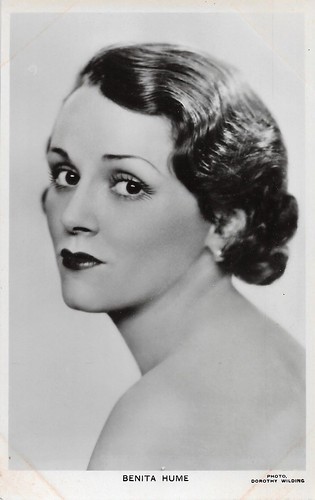
British postcard in the Picturegoer Series, London, no. 447a. Photo: Dorothy Wilding.
Sources: Wikipedia (English, French, and German), and .

British Real Photograph postcard by Sarony, no. 2 of a fifth series of 25 Cinema Stars, issued with Sarony Cigarettes.

British postcard in the Cameo Series, London, no. K.32.

British postcard by Art Photo, no. 139. Photo: Metro-Goldwyn-Mayer.
Overheated leaders of the US and United Europe
Benita Hume was born as Benita Humm in Beckenham, London, England, in 1907. She was the daughter of Henry Josiah Humm and Jane Humm née Duff.
Hume started out as a pianist but pursued acting because she wanted "excitement", according to IMDb . She did the RADA theatre academy and the seventeen-year-old started to act on stage in 1924.
From 1925 she played small parts in British cinema e.g. in Alfred Hitchcock 's Easy Virtue (1927), and she had her first major part in the spy drama Second to None (Jack Raymond, 1927).
She was one of the Sanger sisters in The Constant Nymph (Adrian Brunel, 1928), starring Ivor Novello and Mabel Poulton, and had the female lead in the period piece Balaclava (Maurice Elvey, Milton Rosmer, 1928), set during the Crimean War. Elvey shot the silent version, but Rosmer reshot much to turn it into a talkie.
In A South Sea Bubble (T. Hayes Hunter, 1928), Hume was paired again with Ivor Novello , but now as the leading lady. Again Brunel directed her in A Light Woman (Adrian Brunel 1928), in which she was the star, while she was the title character in The Lady of the Lake (James A. FitzPatrick, 1928).
In the Science-Fiction film High Treason (Maurice Elvey, 1929), shot both as silent and sound version, pacifist women led by Hume's character and her father unite to prevent overheated leaders of the US and United Europe (it is SF!) and war-mongering financiers and agitators from engineering a second world war.
Hume next played in two more crime films: The Clue of the New Pin (Athur Maude, 1929) and the German-British co-production Der Würger/The Wrecker (Géza von Bolváry, 1929), based on an Edgar Wallace novel.

British postcard by Film Weekly. Photo: Fox Film. Benita Hume and Adolphe Menjou in the American pre-Code movie The Worst Woman in Paris? (Monta Bell, 1933).

British postcard by Film Weekly. Photo: Fox Film. Benita Hume in The Worst Woman in Paris? (Monta Bell, 1933).

British postcard by Film Weekly. Photo: Fox Film. Benita Hume and Adolphe Menjou in the American pre-Code movie The Worst Woman in Paris? (Monta Bell, 1933).

British postcard by Film Weekly. Photo: Fox Film. Benita Hume and Harvey Stephens in the American pre-Code movie The Worst Woman in Paris? (Monta Bell, 1933).
A series of well-coiffed English ladies in RKO and MGM films
In 1930, Benita Hume won the female leading role in Ivor Novello 's hit play 'Symphony in Two Flats'. She accompanied Novello when he took the play to the U.S.A. and it became her successful Broadway debut. In the same year, she acted in the UK film version of the play, Symphony in Two Flats (Gareth Gundrey, 1930).
She continued to act in various British crime films and dramas by Maurice Elvey and others. In 1931 she would divorce her first husband, Eric Otto Siepmann, whom she had married in 1926 when she was 19.
After one Warner production shot at their UK studios in 1932, Hume also started a prolific even if short-lived career as the leading lady in Hollywood cinema, though she never became a huge star. IMDb : "she played a series of well-coiffed English ladies in RKO and MGM films". In fact, Hume acted in 11 American films between 1932 and 1933. After the impostors' story Diamond Cut Diamond (Maurice Elvey, Fred Niblo, 1932), with Adolphe Menjou , she acted in such films as the press drama Clear All Wires! (George Hill, 1933) with Lee Tracy, and The Worst Woman in Paris? (Monta Bell, 1933), which was her last American film.
From the second half of 1934, Hume acted in British films again. For some films, she was occasionally called to the US again, e.g. for Tarzan Escapes (Richard Thorpe, 1936) starring Johnny Weissmuller , though not as the female star of the films anymore.
In 1938 Hume quit film acting altogether, though she continued with radio and TV work. In 1938 Benita Hume married British actor Ronald Colman , with whom she appeared on the Jack Benny radio show. They were supposed to be Jack's next-door neighbours, and were usually referred to as "Ronnie and Benita". Their episodes usually dealt with either Jack embarrassing the couple in public or trying to weasel his way into a Colman party at their house.
Hume and Colman also starred in the radio show 'The Halls of Ivy' (1950-1952) and the TV version The Halls of Ivy (1954-1955). The couple co-owned a resort in California and had one daughter, Juliet (1944). After Colman's death in 1958, Hume remarried with British actor George Sanders in 1959. They remained together till her death. Benita Hume died in 1967 at Egerton, Kent, UK, due to bone cancer. She was 61. Hume was cremated and her ashes were scattered at the Charing Crematorium, aka Kent County Crematorium.

British postcard by Film Weekly. Photo: MGM. Lee Tracy and Benita Hume in the American pre-Code comedy Clear All Wires! (George Hill, 1933). Left of Tracy stands James Gleason.

British postcard by Film Weekly. Photo: MGM. Lee Tracy and Benita Hume in the American pre-Code comedy Clear All Wires! (George Hill, 1933). Left stands James Gleason.

British postcard by Film Weekly, London, Series 112.

British postcard in the Picturegoer Series, London, no. 447a. Photo: Dorothy Wilding.
Sources: Wikipedia (English, French, and German), and .
Published on August 04, 2021 22:00
August 3, 2021
Beppo Brem
Beppo Brem (1906-1990) was a German comedian, stage and film actor. He became known as a Bavarian folk actor and appeared in over 200 films, including classics by Max Ophüls, Kurt Hoffmann, and Helmut Käutner.
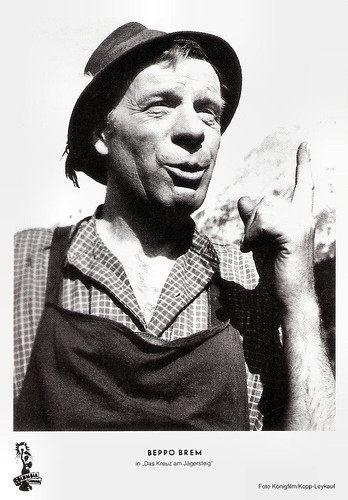
West-German postcard by Kunst und Bild, Berlin, no A 1198, reprint in a limited anniversary edition, no. KN 64. Beppo Brem in Das Kreuz am Jägersteig/The cross on the Jägersteig (Hermann Kugelstadt, 1954).
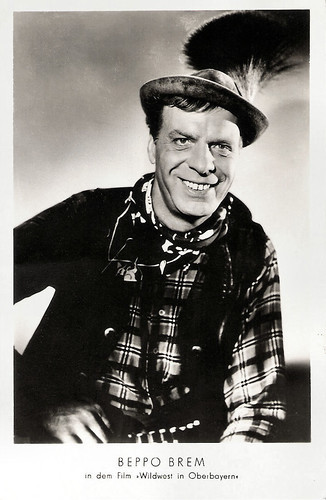
East-German postcard by VEB Volkskunstverlag Reichenbach i. V., no. G 705, 1956. Beppo Brem in Wildwest in Oberbayern/Wild West in Upper Bavaria (Ferdinand Dörfler, 1951).
Max Ophüls
Beppo Brem was born Josef Beppo Brem in Munich, Germany in 1909. He was the son of Josef Brem and his wife Maria. His father was a stonemason and beer brewer and Beppo grew up in the Schwabing district of Munich.
Brem studied to become a cabinet maker and his first job was for the Munich Kammerspiele as a stage carpenter. There he discovered his love for the theatre and got a job on stage as an extra.
From 1925 he took acting lessons and in 1927, he got his first contract with the Bauernbühne (Framer's stage) in Bad Reichenhall, Bavaria. From then on, he acted in theatres in Ulm, Regensburg, Berlin, and Munich, and appeared in such plays as Friedrich Schiller's 'Don Karlos' and Carl Zuckmayer's 'Schinderhannes'.
His first film was Die verkaufte Braut/The Bartered Bride (Max Ophüls, 1932) in which he already impersonated a small part as the rough-and-tumble peasant. The following years, he would play this role over and over again and for which he was extremely well suited because of his coarse appearance and his gentle nature. His next film was Muß man sich gleich scheiden lassen/Do you have to get a divorce right away? (Hans Behrendt, 1933).
Other well-known films, in which he appeared until 1944, were the comedies Das sündige Dorf/The sinful village (Joe Stöckel, 1940), Quax, der Bruchpilot/Quax, the break pilot (Kurt Hoffmann, 1941), Kohlhiesels Töchter/Kohlhiesel's daughters (Kurt Hoffmann, 1943) and Die falsche Braut/The False Bride (Joe Stöckel, 1944). He also worked in the Nazi propaganda films Stoßtrupp 1917/Shock Troop (Ludwig Schmid-Wildy, Hans Zöberlein, 1934), Unternehmen Michael/The Private's Job (Karl Ritter, 1937), Stukas (Karl Ritter, 1941) and Venus vor Gericht (Hans H. Zerlett, 1941). He was named on Joseph Goebbels' "Gottbegnadeten" list as an important German actor.
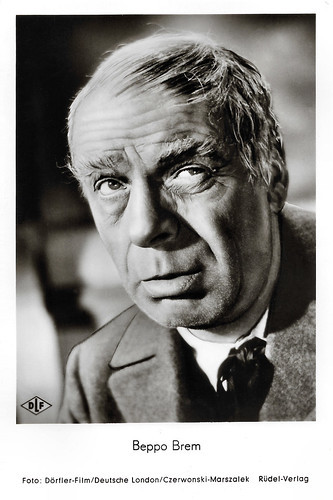
West-German postcard by Rüdel-Verlag, Hamburg-Bergedorf, no. 1767.Photo: Dörfler-Film / Deutsche London (DLF) / Czerwonski - Marszalek. Beppo Brem in Die fröhliche Wallfahrt/The happy pilgrimage (Ferdinand Dörfler, 1956).
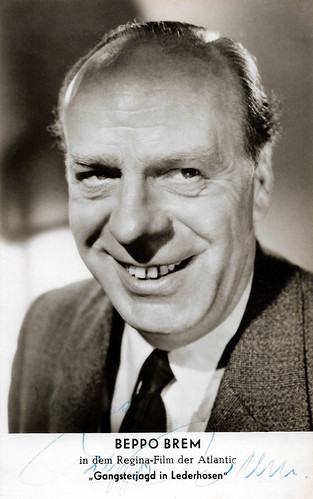
West-German postcard. Photo: Regina / Atlantic. Beppo Brem in Gangsterjagd in Lederhosen/Gangster hunt in lederhosen (Hubert von Blücher, 1959).
Helmut Käutner
During the 1950s, Beppo Brem became very popular with his Heimat films and comedies together with his friend, actor, and director Joe Stöckel. Because of the death of Stöckel in 1959, the promising future of this duo came to an end.
He also played with stars such as Heinz Rühmann , Hans Moser , Johannes Heesters , Hans Albers , Heinz Erhardt, Peter Alexander and Theo Lingen . With his parts in Kurt Hoffmann's Fanfaren der Liebe (1951) and in Helmut Käutner's Des Teufels General (1955) with Curd Jürgens, he got the chance to play a few serious characters, which were an exception. Altogether Beppo Brem appeared in over 200 films and did some guest appearances on TV, especially in the plays by Ludwig Thoma.
In 1956, he appeared with Liesl Karlstadt in the first commercial on German television, produced by Henkel for their washing powder Persil. During 1956, several commercials for this product were produced with sketch-like plots, all starring the Bavarian acting duo.
In the 1960s Brem appeared in mediocre film comedies such as Lausbubengeschichten (Helmut Käutner, 1964), the first of five film adaptations of the stories of the same name by the Bavarian native writer Ludwig Thoma. As the popularity of the Heimat and Schlagerfilms diminished, the actor also participated in some German sex films of the 1970s, which did not detract from his popularity. In the theatre, he could escape the cliché and played broken characters and insignificant figures.
From 1965 to 1970, he played the title role of 'Inspector Wanninger' in about 117 episodes of the TV crime series Die seltsamen Methoden des Franz Josef Wanninger. Wanninger, a Bavarian version of Maigret, was a cunning police inspector, who solved his case unconventionally. The series was continued from 1978 to 1982 with the title Die unsterblichen Methoden des Franz Josef Wanninger. There were a total of 117 episodes. A highlight of his late work was his portrayal of the caretaker in the comedy Hexenschuß (1987) with Helmut Fischer.
Beppo Brem made his last appearances in the play 'Der verkaufte Großvater', in the TV series Heidi und Erni and as a retired tram driver in the melancholy drama Auf dem Abstellgleis (1989) with Erni Singerl and Toni Berger. Shortly after finishing this film, Beppo Brem passed away in 1990 in a hospital in Munich from lung cancer. He was 84. Brem was married to Marga Wening from 1932 till he passed away. From this marriage, a daughter was born. In 1983 Brem was honored with the Bundesverdienstkreuz (Order of Merit of the Federal Republic of Germany).
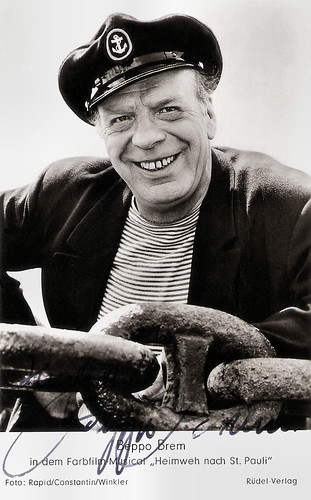
West-German postcard by Rüdel-Verlag, Photo: Rapid / Constantin / Winkler. Beppo Brem in Heimweh nach St. Pauli/Homesick for St. Paul (Werner Jacobs, 1963).
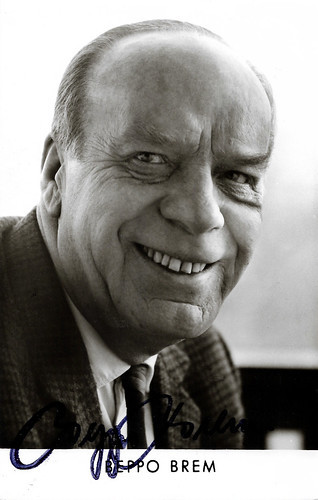
West-German autograph card.
Sources: Wikipedia (Dutch and German) and .

West-German postcard by Kunst und Bild, Berlin, no A 1198, reprint in a limited anniversary edition, no. KN 64. Beppo Brem in Das Kreuz am Jägersteig/The cross on the Jägersteig (Hermann Kugelstadt, 1954).

East-German postcard by VEB Volkskunstverlag Reichenbach i. V., no. G 705, 1956. Beppo Brem in Wildwest in Oberbayern/Wild West in Upper Bavaria (Ferdinand Dörfler, 1951).
Max Ophüls
Beppo Brem was born Josef Beppo Brem in Munich, Germany in 1909. He was the son of Josef Brem and his wife Maria. His father was a stonemason and beer brewer and Beppo grew up in the Schwabing district of Munich.
Brem studied to become a cabinet maker and his first job was for the Munich Kammerspiele as a stage carpenter. There he discovered his love for the theatre and got a job on stage as an extra.
From 1925 he took acting lessons and in 1927, he got his first contract with the Bauernbühne (Framer's stage) in Bad Reichenhall, Bavaria. From then on, he acted in theatres in Ulm, Regensburg, Berlin, and Munich, and appeared in such plays as Friedrich Schiller's 'Don Karlos' and Carl Zuckmayer's 'Schinderhannes'.
His first film was Die verkaufte Braut/The Bartered Bride (Max Ophüls, 1932) in which he already impersonated a small part as the rough-and-tumble peasant. The following years, he would play this role over and over again and for which he was extremely well suited because of his coarse appearance and his gentle nature. His next film was Muß man sich gleich scheiden lassen/Do you have to get a divorce right away? (Hans Behrendt, 1933).
Other well-known films, in which he appeared until 1944, were the comedies Das sündige Dorf/The sinful village (Joe Stöckel, 1940), Quax, der Bruchpilot/Quax, the break pilot (Kurt Hoffmann, 1941), Kohlhiesels Töchter/Kohlhiesel's daughters (Kurt Hoffmann, 1943) and Die falsche Braut/The False Bride (Joe Stöckel, 1944). He also worked in the Nazi propaganda films Stoßtrupp 1917/Shock Troop (Ludwig Schmid-Wildy, Hans Zöberlein, 1934), Unternehmen Michael/The Private's Job (Karl Ritter, 1937), Stukas (Karl Ritter, 1941) and Venus vor Gericht (Hans H. Zerlett, 1941). He was named on Joseph Goebbels' "Gottbegnadeten" list as an important German actor.

West-German postcard by Rüdel-Verlag, Hamburg-Bergedorf, no. 1767.Photo: Dörfler-Film / Deutsche London (DLF) / Czerwonski - Marszalek. Beppo Brem in Die fröhliche Wallfahrt/The happy pilgrimage (Ferdinand Dörfler, 1956).

West-German postcard. Photo: Regina / Atlantic. Beppo Brem in Gangsterjagd in Lederhosen/Gangster hunt in lederhosen (Hubert von Blücher, 1959).
Helmut Käutner
During the 1950s, Beppo Brem became very popular with his Heimat films and comedies together with his friend, actor, and director Joe Stöckel. Because of the death of Stöckel in 1959, the promising future of this duo came to an end.
He also played with stars such as Heinz Rühmann , Hans Moser , Johannes Heesters , Hans Albers , Heinz Erhardt, Peter Alexander and Theo Lingen . With his parts in Kurt Hoffmann's Fanfaren der Liebe (1951) and in Helmut Käutner's Des Teufels General (1955) with Curd Jürgens, he got the chance to play a few serious characters, which were an exception. Altogether Beppo Brem appeared in over 200 films and did some guest appearances on TV, especially in the plays by Ludwig Thoma.
In 1956, he appeared with Liesl Karlstadt in the first commercial on German television, produced by Henkel for their washing powder Persil. During 1956, several commercials for this product were produced with sketch-like plots, all starring the Bavarian acting duo.
In the 1960s Brem appeared in mediocre film comedies such as Lausbubengeschichten (Helmut Käutner, 1964), the first of five film adaptations of the stories of the same name by the Bavarian native writer Ludwig Thoma. As the popularity of the Heimat and Schlagerfilms diminished, the actor also participated in some German sex films of the 1970s, which did not detract from his popularity. In the theatre, he could escape the cliché and played broken characters and insignificant figures.
From 1965 to 1970, he played the title role of 'Inspector Wanninger' in about 117 episodes of the TV crime series Die seltsamen Methoden des Franz Josef Wanninger. Wanninger, a Bavarian version of Maigret, was a cunning police inspector, who solved his case unconventionally. The series was continued from 1978 to 1982 with the title Die unsterblichen Methoden des Franz Josef Wanninger. There were a total of 117 episodes. A highlight of his late work was his portrayal of the caretaker in the comedy Hexenschuß (1987) with Helmut Fischer.
Beppo Brem made his last appearances in the play 'Der verkaufte Großvater', in the TV series Heidi und Erni and as a retired tram driver in the melancholy drama Auf dem Abstellgleis (1989) with Erni Singerl and Toni Berger. Shortly after finishing this film, Beppo Brem passed away in 1990 in a hospital in Munich from lung cancer. He was 84. Brem was married to Marga Wening from 1932 till he passed away. From this marriage, a daughter was born. In 1983 Brem was honored with the Bundesverdienstkreuz (Order of Merit of the Federal Republic of Germany).

West-German postcard by Rüdel-Verlag, Photo: Rapid / Constantin / Winkler. Beppo Brem in Heimweh nach St. Pauli/Homesick for St. Paul (Werner Jacobs, 1963).

West-German autograph card.
Sources: Wikipedia (Dutch and German) and .
Published on August 03, 2021 22:00
August 2, 2021
Boucot
Just like the more famous Dranem, Louis-Jacques Boucot aka Boucot (1882-1949) was a comical actor known for his vivacity and grimaces who knew a career from music-hall to cinema. The French stage and screen actor was famous for his comic characters of Pénard and Babylas.
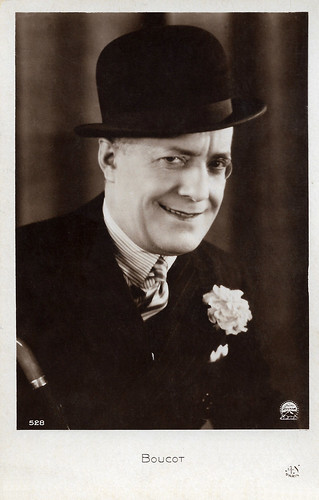
French postcard by A.N., Paris, no. 528. Photo: Paramount.
Silent films by Pathé Frères
Louis-Jacques Boucot also known under the pseudonyms Louis Boucaud or (Louis) Boucot was born in Paris in 1882.
In 1910, Boucot started acting at Pathé Frères and made his debut in Une petite femme bien douce/A very sweet little woman (Georges Denola, 1910), scripted and performed by Mistinguett .
By 1911 he had his own comedies such as the comedy Un ami trop entreprenant/A friend who is too enterprising (N.N., 1911) with Paulette Lorsy, and La dame de compagnie/The lady companion (Louis Feuillere, 1911), in which he appeared anonymously.
In the same year, he also developed the popular comic character of Babylas in various shorts directed by Alfred Machin . Sometimes, Machin's pet panther Mimir acted in these films too, such as in Babylas vient d'hériter d'une panthère/Babylas has just inherited a panther (1911). The last comedy in the series was Babylas va se marier/Babylas is getting married (Alfred Machin, 1912).
In 1912 Boucot also developed another character, Pénard, with whom he made 16 short comedies in 1912-1913, all for Pathé.
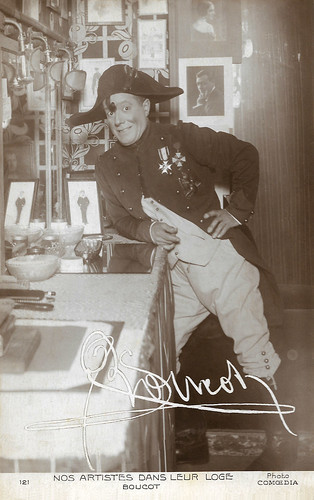
French postcard in the Nos artistes dans leur loge series, no. 121. Photo: Comoedia, Paris.
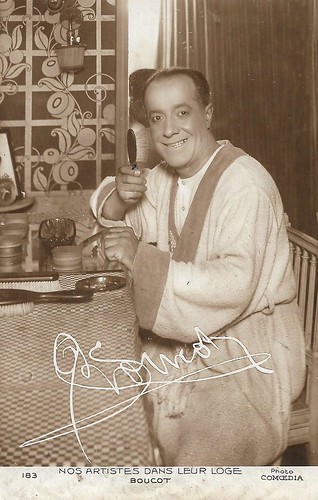
French postcard in the Nos artistes dans leur loge series, no. 183. Photo: Comoedia, Paris.
Leads in sound films
During the First World War, Boucot acted in only one Babylas comedy, Babylas marraine/Babylas godmother (N.N., 1917).
In the 1920s, he also appeared in only one film, La première idylle de Boucot/Boucot's first idyll (Robert Saidreau, 1920).
He only returned to the screen when the sound film had set in. Between 1930 and 1938, he would act in 14 films such as the drama Une femme a menti/A woman lied (Charles de Rochefort, 1930) for Paramount, the musical comedy Arthur (Léonce Perret, 1931) with Boucot in the lead, and Le costaud des PTT/The strong PTT (Jean Bertin, 1931) in which he sang several songs.
The following years he could be seen in La bonne aventure/The Nice Adventure (Henri Diamant-Berger, 1932) with again Boucot in the lead, Brevet 95-75/Patent 95-75 (Pierre Miquel, 1934), and the crime film Le puritain/The Puritan (Jeff Musso, 1938) with Pierre Fresnay and Jean-Louis Barrault.
His final films were the Operetta Les trois valses/Three Waltzes (Ludwig Berger, 1938) starring Yvonne Printemps and Pierre Fresnay and based on music by Oscar Straus, and La Présidente/The president (Fernand Rivers, 1938), starring Elvire Popesco .
Boucot passed away in his hometown Paris in 1949. He was 66.
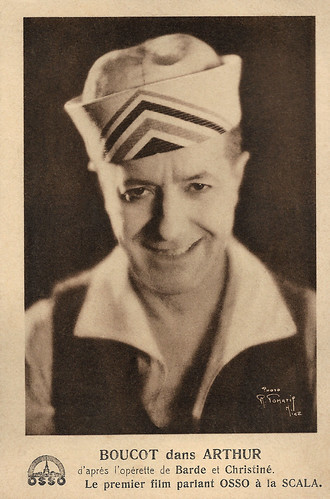
Belgian postcard bt Ern. Thill, Bruxelles (Nels). Photo: R. Tomarif (?), Nice / Les Films Osso. Boucot in Arthur (Léonce Perret, 1930).
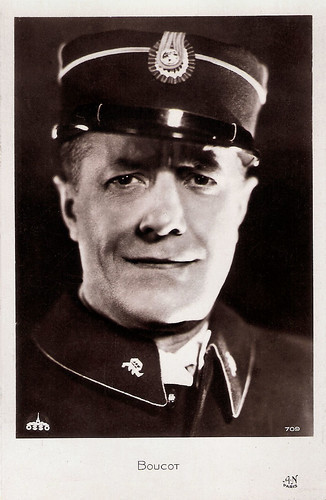
French postcard by A.N. (A. Noyer), Paris, no. 709. Photo: Les Films Osso. Louis-Jacques Boucot aka Boucot.
Sources: Wikipedia (French and English), and .

French postcard by A.N., Paris, no. 528. Photo: Paramount.
Silent films by Pathé Frères
Louis-Jacques Boucot also known under the pseudonyms Louis Boucaud or (Louis) Boucot was born in Paris in 1882.
In 1910, Boucot started acting at Pathé Frères and made his debut in Une petite femme bien douce/A very sweet little woman (Georges Denola, 1910), scripted and performed by Mistinguett .
By 1911 he had his own comedies such as the comedy Un ami trop entreprenant/A friend who is too enterprising (N.N., 1911) with Paulette Lorsy, and La dame de compagnie/The lady companion (Louis Feuillere, 1911), in which he appeared anonymously.
In the same year, he also developed the popular comic character of Babylas in various shorts directed by Alfred Machin . Sometimes, Machin's pet panther Mimir acted in these films too, such as in Babylas vient d'hériter d'une panthère/Babylas has just inherited a panther (1911). The last comedy in the series was Babylas va se marier/Babylas is getting married (Alfred Machin, 1912).
In 1912 Boucot also developed another character, Pénard, with whom he made 16 short comedies in 1912-1913, all for Pathé.

French postcard in the Nos artistes dans leur loge series, no. 121. Photo: Comoedia, Paris.

French postcard in the Nos artistes dans leur loge series, no. 183. Photo: Comoedia, Paris.
Leads in sound films
During the First World War, Boucot acted in only one Babylas comedy, Babylas marraine/Babylas godmother (N.N., 1917).
In the 1920s, he also appeared in only one film, La première idylle de Boucot/Boucot's first idyll (Robert Saidreau, 1920).
He only returned to the screen when the sound film had set in. Between 1930 and 1938, he would act in 14 films such as the drama Une femme a menti/A woman lied (Charles de Rochefort, 1930) for Paramount, the musical comedy Arthur (Léonce Perret, 1931) with Boucot in the lead, and Le costaud des PTT/The strong PTT (Jean Bertin, 1931) in which he sang several songs.
The following years he could be seen in La bonne aventure/The Nice Adventure (Henri Diamant-Berger, 1932) with again Boucot in the lead, Brevet 95-75/Patent 95-75 (Pierre Miquel, 1934), and the crime film Le puritain/The Puritan (Jeff Musso, 1938) with Pierre Fresnay and Jean-Louis Barrault.
His final films were the Operetta Les trois valses/Three Waltzes (Ludwig Berger, 1938) starring Yvonne Printemps and Pierre Fresnay and based on music by Oscar Straus, and La Présidente/The president (Fernand Rivers, 1938), starring Elvire Popesco .
Boucot passed away in his hometown Paris in 1949. He was 66.

Belgian postcard bt Ern. Thill, Bruxelles (Nels). Photo: R. Tomarif (?), Nice / Les Films Osso. Boucot in Arthur (Léonce Perret, 1930).

French postcard by A.N. (A. Noyer), Paris, no. 709. Photo: Les Films Osso. Louis-Jacques Boucot aka Boucot.
Sources: Wikipedia (French and English), and .
Published on August 02, 2021 22:00
August 1, 2021
Maria Zelenka
Maria Zelenka (1894–1975) was an Austrian film actress, who peaked in the Weimar cinema of the 1920s. After one short sound film, her career in the cinema was over.
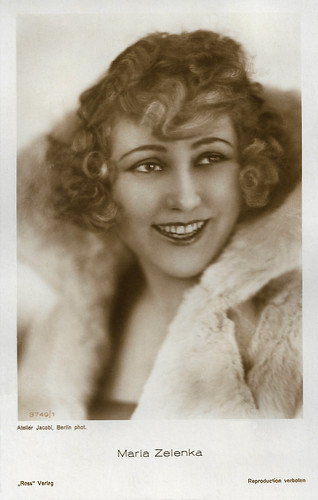
German postcard by Ross Verlag, Berlin, no. 3749/1. Photo Atelier Jacobi, Berlin.
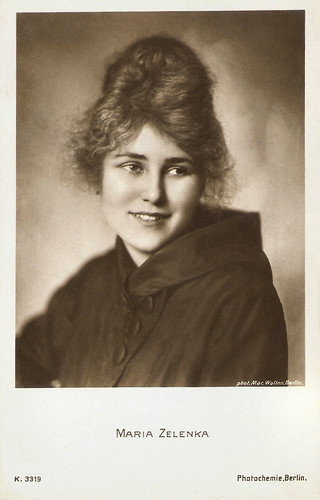
German postcard by Photochemie, Berlin, no. 3319. Photo: Mac Walten, Berlin.
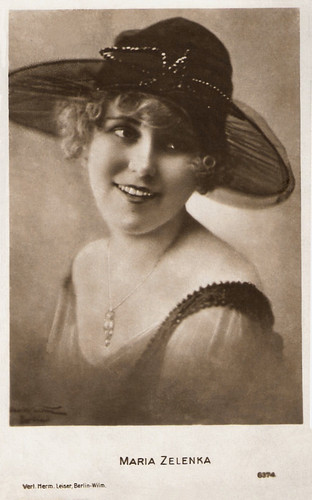
German postcard by Verlag Herm. Leiser, Berlin -Wilm., no. 6374.
Drama school for only 14 days
Maria Zelenka, also called Mizzi, was born in 1894 in Höbersdorf (Lower Austria) as the first daughter of Johann Zelenka, a tramway coachman in Vienna-Döbling, and Johanna Kerschl.
After attending the Otto drama school for only 14 days, Maria Zelenka was already able to celebrate her first stage success in 1914 at the Linz Landestheater as Käthi in the play 'Alt-Heidelberg'.
Later Maria Zelenka received engagements at the Stadttheater Nuremberg, the Hoftheater Mannheim, the Hofburgtheater Vienna and the Hoftheater Munich. She played the title role in 'Minna von Barnhelm', Klärchen in 'Egmont' and Gretchen in 'Faust'.
In 1918, she made her film debut during the war as a supporting actress by companies like Luna and Deutsche Bioscop. IMDb : "In a newspaper, she read the advertisement: 'Young and pretty actress will be trained to a first-class actress by a capable director.'" She got in touch with the company, the May-Film-GmbH of director and producer Joe May , and got a contract on the base of two months. However, immediately after signing with Joe May , the Danny Kaden-Film GmbH offered her a two-year contract. IMDb : "They had to pay a transfer fee and Maria Zelenka signed the contract which was the beginning of an impressive film career."
She had her first lead as Mizzi in Das blonde Vergnügen/The blonde pleasure (Danny Kaden, 1918), followed by leads in Im Dienste der Liebe/In the service of love (Fred Sauer, 1919) with Friedrich Zelnik , Ewige Schönheit/Eternal beauty (Rudolf Walther-Fein, 1919) and Das Schicksal der Maria Keith/The fate of Maria Keith (Walther Fein, 1919).
She also had the female lead in Alkohol/Alcohol (Alfred Lind, E.A. Dupont, 1920) as a young woman saved in a fire by the father from her fiancee, an ex-convict who has done time for murder. It was one in a series of 'Aufklärungsfilme' (Enlightenment films) examining social issues, which were produced around the time.
In the two-part Die Hafenlore/Harbour Lore (Wolfgang Neff, 1921) she was the title character, while she had the female lead opposite Conrad Veidt in Liebestaumel/Love and Passion (Martin Hartwig, 1921), and opposite Friedrich Zelnik again in C.d.E./Der Club der Entgleisten/The Club of the Derailed (Rolf Petersen, 1922).
She was again the title character Lotte in Neff's Bummellote/Strolling Lotte (Wolfgang Neff, 1922), and also had the female lead in Neff's Morast/Morass (Wolfgang Neff, 1922). Also in Ich bin Du/I am You (Urban Gad, Hans Mierendorff, 1921) Zelenka had the lead opposite Hans Mierendorff . Yet, at the same time, Zelenka also did many supporting parts, as in Neff's three-part Großstadtmädels/Big City Girls (Wolfgang Neff, 1921), a Hegewald-Film production - which produced many films directed by - the highly productive - Neff, including Die Hafenlore, Morast and Bummellotte.
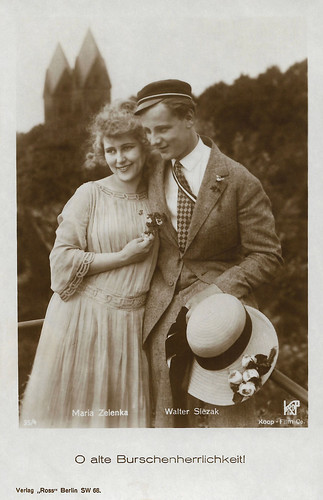
German postcard by Ross Verlag, Berlin, no. 35/4. Photo: Koop-Film Co. Maria Zelenka and Walter Slezak in O alte Burschenherrlichkeit!/Oh Those Glorious Old Student Days (Helene Lackner, Eugen Rex, 1925).
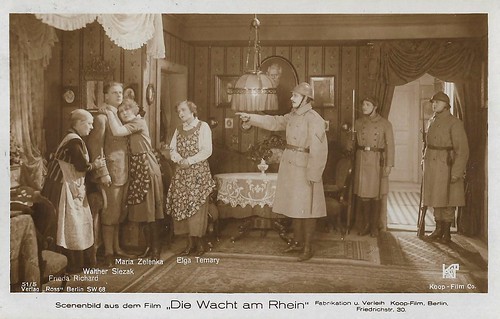
German postcard by Ross Verlag, Berlin, no. 51/5. Photo: Koop-Film, Berlin. Walter Slezak as Walter Thiermann, engineer of Franz Großmann, surrounded by his old mother (Frida Richard), his beloved Maria (Maria Zelenka), and his sister Renate (Elza Temary) in Die Wacht am Rhein. Aus des Rheinlands Schicksalstagen (Helene Lackner, 1925-1926). Elza is misspelled as Elga here.
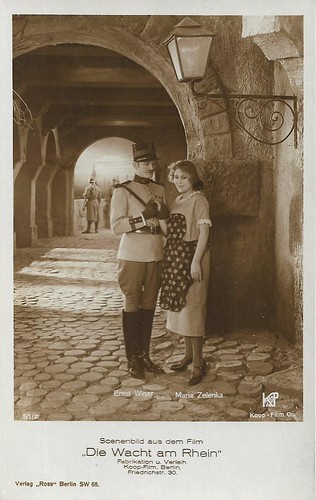
German postcard by Ross Verlag, Berlin, bo. 51/2. Photo: Koop-Film, Berlin. Ernst Winar as French Captain René Clavignac and Maria Zelenka as Maria Krenz, daughter of the castle owner August Krenz, in Die Wacht am Rhein. Aus des Rheinlands Schicksalstagen (Helene Lackner, 1925-1926).
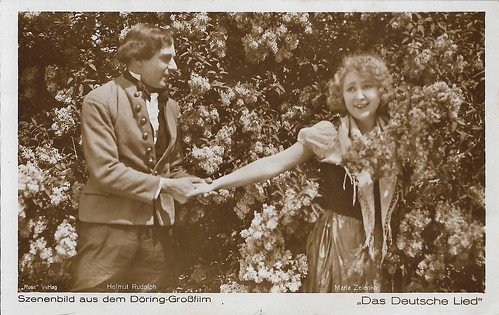
German postcard by Ross Verlag, unnumbered. Helmut Rudolph and Maria Zelenka as Johannes Forster and his wife Katharina in Das deutsche Lied/The German song (Karl Pindl, 1928). The film honored the social status and historical significance of German songwriting.
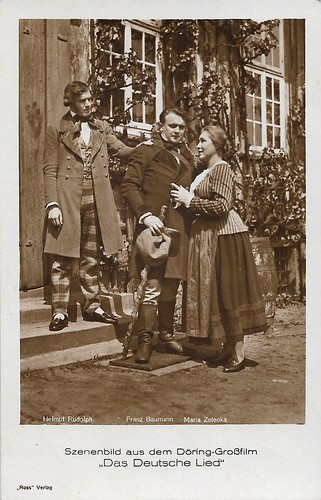
German postcard by Ross Verlag, unnumbered. Helmut Rudolph, Franz Baumann and Maria Zelenka in Das deutsche Lied/The German song (Karl Pindl, 1928).
Completely forgotten
After 1922 Matia Zelenka's career became less intense. She stil had the female lead in Barfüßele - Ein Schwarzwaldidyll/Barfüßele - A Schwarzwald Idyll (Heinrich Lisson, 1924) with Sig Arno , Der Aufstieg der kleinen Lilian (Fred Sauer, 1925) with Bruno Kastner , and Die Erbin von St. Alban/The heiress of St. Alban (Fid. Robbra, 1925).
She also played the female lead in O alte Burschenherrlichkeit/Oh Those Glorious Old Student Days (Helene Lackner, Eugen Rex, 1925), set in the student milieu, and with Charles Willy Kayser , Walter Slezak, and Karl Beckersachs as students.
In the film Die Wacht am Rhein. Aus des Rheinlands Schicksalstagen/Watch on the Rhine (Helene Lackner, 1925-1926), Zelenka has befriended a French captain ( Ernst Winar ) during the French occupation of the Rhineland, until the French arrest her fiancee ( Walter Slezak ).
The last silent parts of Zelenka were in Die Fahrt ins Glück/The journey to happiness (Henrich Linsson, 1927), Kindertragödie/Children's Tragedy (Phil Jutzi, Karl Lutz, 1928) - made by the Communist-backed studio Prometheus-Film, and Das deutsche Lied/The German song (Karl Pindl, 1928) - produced by the German singers union.
Her final film part was in the short sound film Wie kommen die Löcher in den Käse?/How do the holes get in the cheese? (Erich Waschneck, 1932). In 1933 and 1934 Zelenka did guest appearances on stage with her husband, actor, singer, and director Alfred Läutner, who was, however, expelled from the Reich Theatre and Reich Film Chamber in 1935.
The advent of the talkies ended her career, and the once busy actress was completely forgotten after World War II. Since the death of her husband (1943), Maria Zelenka lived in Vienna. There she passed away in 1975.
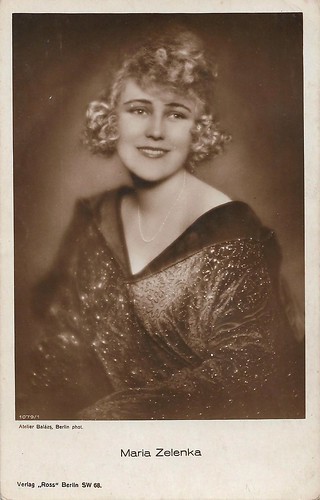
German postcard by Ross Verlag, Berlin, no. 1079/1, 1927-1928. Photo: Atelier Balazs, Berlin.
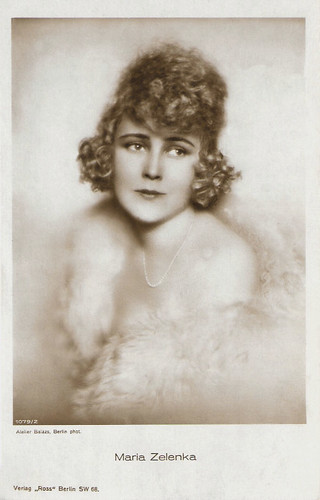
German postcard by Ross Verlag, Berlin, no. 1079/2, 1927-1928. Photo: Atelier Balazs, Berlin.
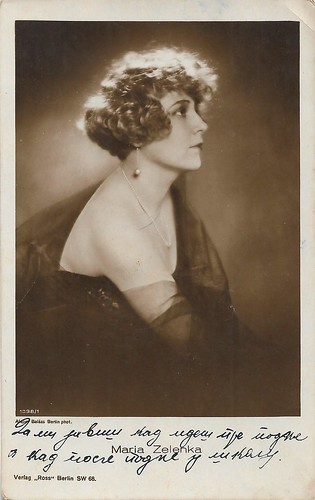
German postcard by Ross Verlag, Berlin, no. 1398/1, 1927-1928. Photo: Atelier Balazs. Mailed from former Yugoslavia in 1927.
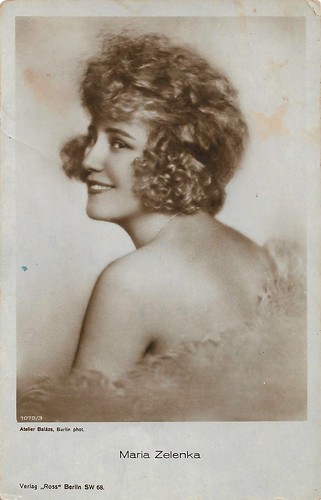
German postcard by Ross Verlag, Berlin, no. 1079/3, 1927-1928. Photo: Atelier Balazs, Berlin.
Sources: Filmportal, Wikipedia (German and English), and .

German postcard by Ross Verlag, Berlin, no. 3749/1. Photo Atelier Jacobi, Berlin.

German postcard by Photochemie, Berlin, no. 3319. Photo: Mac Walten, Berlin.

German postcard by Verlag Herm. Leiser, Berlin -Wilm., no. 6374.
Drama school for only 14 days
Maria Zelenka, also called Mizzi, was born in 1894 in Höbersdorf (Lower Austria) as the first daughter of Johann Zelenka, a tramway coachman in Vienna-Döbling, and Johanna Kerschl.
After attending the Otto drama school for only 14 days, Maria Zelenka was already able to celebrate her first stage success in 1914 at the Linz Landestheater as Käthi in the play 'Alt-Heidelberg'.
Later Maria Zelenka received engagements at the Stadttheater Nuremberg, the Hoftheater Mannheim, the Hofburgtheater Vienna and the Hoftheater Munich. She played the title role in 'Minna von Barnhelm', Klärchen in 'Egmont' and Gretchen in 'Faust'.
In 1918, she made her film debut during the war as a supporting actress by companies like Luna and Deutsche Bioscop. IMDb : "In a newspaper, she read the advertisement: 'Young and pretty actress will be trained to a first-class actress by a capable director.'" She got in touch with the company, the May-Film-GmbH of director and producer Joe May , and got a contract on the base of two months. However, immediately after signing with Joe May , the Danny Kaden-Film GmbH offered her a two-year contract. IMDb : "They had to pay a transfer fee and Maria Zelenka signed the contract which was the beginning of an impressive film career."
She had her first lead as Mizzi in Das blonde Vergnügen/The blonde pleasure (Danny Kaden, 1918), followed by leads in Im Dienste der Liebe/In the service of love (Fred Sauer, 1919) with Friedrich Zelnik , Ewige Schönheit/Eternal beauty (Rudolf Walther-Fein, 1919) and Das Schicksal der Maria Keith/The fate of Maria Keith (Walther Fein, 1919).
She also had the female lead in Alkohol/Alcohol (Alfred Lind, E.A. Dupont, 1920) as a young woman saved in a fire by the father from her fiancee, an ex-convict who has done time for murder. It was one in a series of 'Aufklärungsfilme' (Enlightenment films) examining social issues, which were produced around the time.
In the two-part Die Hafenlore/Harbour Lore (Wolfgang Neff, 1921) she was the title character, while she had the female lead opposite Conrad Veidt in Liebestaumel/Love and Passion (Martin Hartwig, 1921), and opposite Friedrich Zelnik again in C.d.E./Der Club der Entgleisten/The Club of the Derailed (Rolf Petersen, 1922).
She was again the title character Lotte in Neff's Bummellote/Strolling Lotte (Wolfgang Neff, 1922), and also had the female lead in Neff's Morast/Morass (Wolfgang Neff, 1922). Also in Ich bin Du/I am You (Urban Gad, Hans Mierendorff, 1921) Zelenka had the lead opposite Hans Mierendorff . Yet, at the same time, Zelenka also did many supporting parts, as in Neff's three-part Großstadtmädels/Big City Girls (Wolfgang Neff, 1921), a Hegewald-Film production - which produced many films directed by - the highly productive - Neff, including Die Hafenlore, Morast and Bummellotte.

German postcard by Ross Verlag, Berlin, no. 35/4. Photo: Koop-Film Co. Maria Zelenka and Walter Slezak in O alte Burschenherrlichkeit!/Oh Those Glorious Old Student Days (Helene Lackner, Eugen Rex, 1925).

German postcard by Ross Verlag, Berlin, no. 51/5. Photo: Koop-Film, Berlin. Walter Slezak as Walter Thiermann, engineer of Franz Großmann, surrounded by his old mother (Frida Richard), his beloved Maria (Maria Zelenka), and his sister Renate (Elza Temary) in Die Wacht am Rhein. Aus des Rheinlands Schicksalstagen (Helene Lackner, 1925-1926). Elza is misspelled as Elga here.

German postcard by Ross Verlag, Berlin, bo. 51/2. Photo: Koop-Film, Berlin. Ernst Winar as French Captain René Clavignac and Maria Zelenka as Maria Krenz, daughter of the castle owner August Krenz, in Die Wacht am Rhein. Aus des Rheinlands Schicksalstagen (Helene Lackner, 1925-1926).

German postcard by Ross Verlag, unnumbered. Helmut Rudolph and Maria Zelenka as Johannes Forster and his wife Katharina in Das deutsche Lied/The German song (Karl Pindl, 1928). The film honored the social status and historical significance of German songwriting.

German postcard by Ross Verlag, unnumbered. Helmut Rudolph, Franz Baumann and Maria Zelenka in Das deutsche Lied/The German song (Karl Pindl, 1928).
Completely forgotten
After 1922 Matia Zelenka's career became less intense. She stil had the female lead in Barfüßele - Ein Schwarzwaldidyll/Barfüßele - A Schwarzwald Idyll (Heinrich Lisson, 1924) with Sig Arno , Der Aufstieg der kleinen Lilian (Fred Sauer, 1925) with Bruno Kastner , and Die Erbin von St. Alban/The heiress of St. Alban (Fid. Robbra, 1925).
She also played the female lead in O alte Burschenherrlichkeit/Oh Those Glorious Old Student Days (Helene Lackner, Eugen Rex, 1925), set in the student milieu, and with Charles Willy Kayser , Walter Slezak, and Karl Beckersachs as students.
In the film Die Wacht am Rhein. Aus des Rheinlands Schicksalstagen/Watch on the Rhine (Helene Lackner, 1925-1926), Zelenka has befriended a French captain ( Ernst Winar ) during the French occupation of the Rhineland, until the French arrest her fiancee ( Walter Slezak ).
The last silent parts of Zelenka were in Die Fahrt ins Glück/The journey to happiness (Henrich Linsson, 1927), Kindertragödie/Children's Tragedy (Phil Jutzi, Karl Lutz, 1928) - made by the Communist-backed studio Prometheus-Film, and Das deutsche Lied/The German song (Karl Pindl, 1928) - produced by the German singers union.
Her final film part was in the short sound film Wie kommen die Löcher in den Käse?/How do the holes get in the cheese? (Erich Waschneck, 1932). In 1933 and 1934 Zelenka did guest appearances on stage with her husband, actor, singer, and director Alfred Läutner, who was, however, expelled from the Reich Theatre and Reich Film Chamber in 1935.
The advent of the talkies ended her career, and the once busy actress was completely forgotten after World War II. Since the death of her husband (1943), Maria Zelenka lived in Vienna. There she passed away in 1975.

German postcard by Ross Verlag, Berlin, no. 1079/1, 1927-1928. Photo: Atelier Balazs, Berlin.

German postcard by Ross Verlag, Berlin, no. 1079/2, 1927-1928. Photo: Atelier Balazs, Berlin.

German postcard by Ross Verlag, Berlin, no. 1398/1, 1927-1928. Photo: Atelier Balazs. Mailed from former Yugoslavia in 1927.

German postcard by Ross Verlag, Berlin, no. 1079/3, 1927-1928. Photo: Atelier Balazs, Berlin.
Sources: Filmportal, Wikipedia (German and English), and .
Published on August 01, 2021 22:00
July 31, 2021
Michel Strogoff by Albert Bergeret
Around 1900, Jules Verne's 'Michel Strogoff' (Michael Strogoff: The Courier of the Czar) was one of the most popular adventure novels, set in 1860s Imperial Russia. The book, published in 1876, was four years later adapted to a play, by Verne himself and Adolphe d'Ennery. In the 20th century several film adaptations would follow in France, Germany and elsewhere. Ivan Mozzhukhin and Nathalie Kovanko were the stars of the French-German silent film Michel Strogoff (Victor Tourjansky, 1926). Next week at EFSP, a post on one of the best sound film adaptations. Today, we present a curious set of ten 'Michel Strogoff' postcards published by French photographer and publisher Albert Bergeret (1859-1932) from Nancy ca. 1900. The setting of this possibly refers to a stage version of 'Michel Strogoff' but the pictures may also have been staged for Bergeret's own interest.
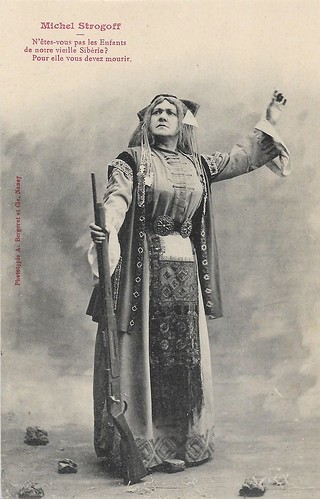
French postcard by Phototypie A. Bergeret et Cie., Nancy. Caption: (Mother Russia:) Aren't you the Children of our old Siberia? For her you need to die.
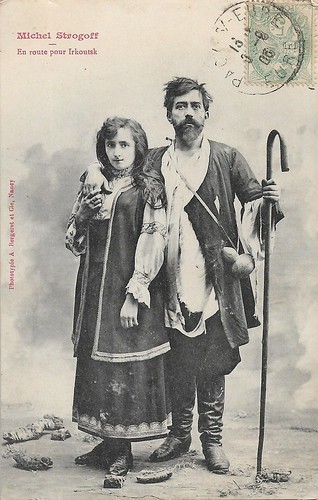
French postcard by Phototypie A. Bergeret et Cie., Nancy. Caption: On the road to Irkutsk.
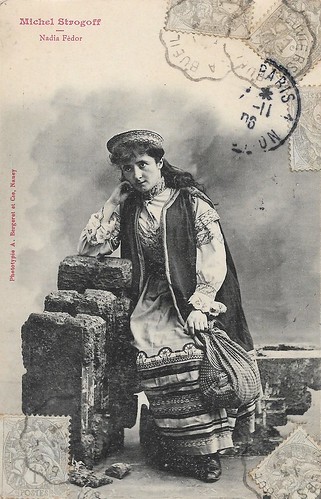
French postcard by Phototypie A. Bergeret et Cie., Nancy. Caption: Nadia Fedor.
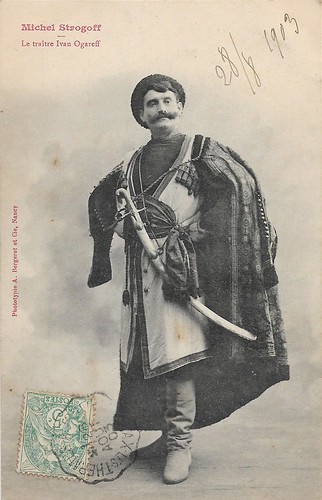
French postcard by Phototypie A. Bergeret et Cie., Nancy. Caption: The traitor Ivan Ogareff.
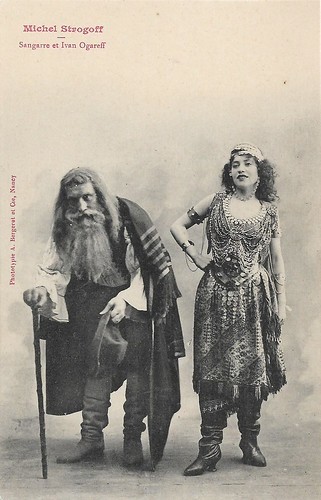
French postcard by Phototypie A. Bergeret et Cie., Nancy. Caption: Caption: Sangarre and Ivan Ogareff.
A courier for Tsar Alexander II
The Michael Strogoff series by Bergeret is unnumbered but we've tried to follow the plot. Michael Strogoff, a 30-year-old native of Omsk, is a courier for Tsar Alexander II of Russia. The Tartar Khan (prince), Feofar Khan, incites a rebellion and separates the Russian Far East from the mainland, severing telegraph lines. Rebels encircle Irkutsk, where the local governor, a brother of the Tsar, is making a last stand. Strogoff is sent to Irkutsk to warn the governor about the traitor Ivan Ogareff, a former colonel, who was once demoted and exiled and now seeks revenge against the imperial family. He intends to gain the governor's trust and then betray him to the Tartar hordes.
On his way to Irkutsk, Strogoff meets Nadia Fedor, daughter of an exiled political prisoner, Basil Fedor, who has been granted permission to join her father at his exile in Irkutsk; the English war correspondent Harry Blount of the Daily Telegraph; and Alcide Jolivet, a Frenchman reporting for his 'cousin Madeleine'. Blount and Jolivet tend to follow the same route as Michael, separating and meeting again all the way through Siberia. He is supposed to travel under a false identity, posing as the pacific merchant Nicolas Korpanoff, but he is discovered by the Tartars when he meets his mother in their home city of Omsk.
Michael, his mother, and Nadia are eventually captured by the Tartar forces, along with thousands of other Russians, during the storming of a city in the Ob basin. The Tartars do not know Strogoff by sight, but Ogareff is aware of the courier's mission and when he is told that Strogoff's mother spotted her son in the crowd and called his name, but received no reply, he understands that Strogoff is among the captured and devises a scheme to force the mother to indicate him.
Strogoff is indeed caught and handed over to the Tartars, and Ogareff alleges that Michael is a spy, hoping to have him put to death in some cruel way. After opening the Koran at random, Feofar decides that Michael will be blinded as punishment in the Tartar fashion, with a glowing hot blade. For several chapters, the reader is led to believe that Michael was indeed blinded, but it transpires in fact that he was saved from this fate (his tears at his mother evaporated and saved his corneas) and was only pretending.
Eventually, Michael and Nadia escape and travel to Irkutsk with a friendly peasant, Nicolas Pigassof. They are recaptured by the Tartars; Nicolas witnesses Nadia being raped by a Tartar soldier and murders Nadia's assaulter. The Tartars then abandon Nadia and Michael and carry Nicolas away, reserving him for greater punishment. Nadia and Michael later discover him buried up to his neck in the ground. They continue onward where they are delayed by fire and the frozen river. However, they eventually reach Irkutsk and warn the Tsar's brother in time of Ivan Ogareff. Nadia's father, who has been appointed commander of a suicide battalion and later pardoned, joins them and Michael and Nadia are married.
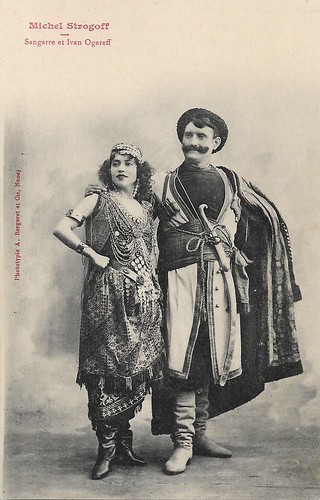
French postcard by Phototypie A. Bergeret et Cie., Nancy. Caption: Caption: Sangarre and Ivan Ogareff.
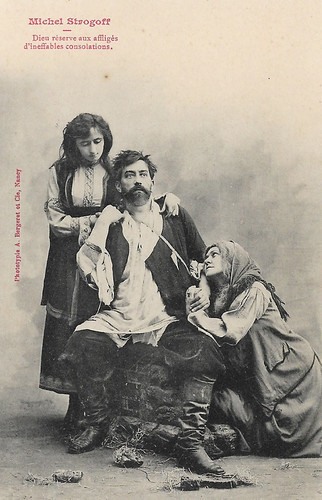
French postcard by Phototypie A. Bergeret et Cie., Nancy. Caption: God offers the afflicted ineffable consolations.
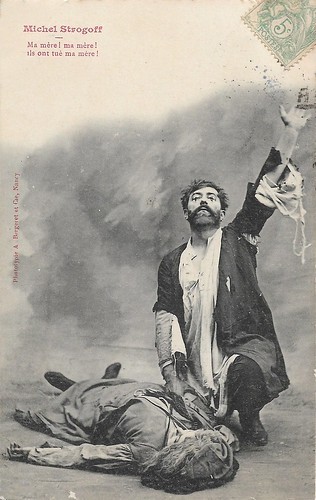
French postcard by Phototypie A. Bergeret et Cie., Nancy. Caption: My mother! My mother! They killed my mother!
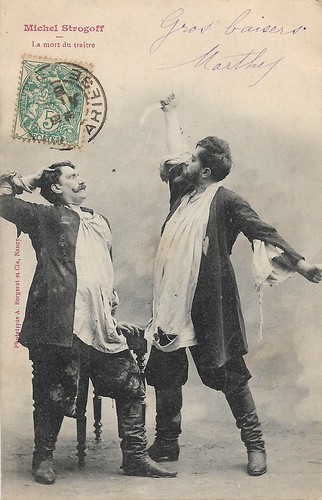
French postcard by Phototypie A. Bergeret et Cie., Nancy. Caption: The death of the traitor.
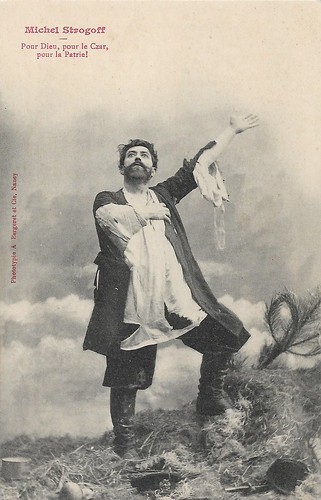
French postcard by Phototypie A. Bergeret et Cie., Nancy. Caption: For God, czar, and fatherland! Following the thread of the plot, this could be the last card. Yet, this card talks about consolations by God, which may refer to Michel getting his sight again. When his mother faints when he is blinded, his tears have saved his eyes. So that card could also be the last or penultimate card.
Sources: Gazette Drouot (French), and Wikipedia (French and English).

French postcard by Phototypie A. Bergeret et Cie., Nancy. Caption: (Mother Russia:) Aren't you the Children of our old Siberia? For her you need to die.

French postcard by Phototypie A. Bergeret et Cie., Nancy. Caption: On the road to Irkutsk.

French postcard by Phototypie A. Bergeret et Cie., Nancy. Caption: Nadia Fedor.

French postcard by Phototypie A. Bergeret et Cie., Nancy. Caption: The traitor Ivan Ogareff.

French postcard by Phototypie A. Bergeret et Cie., Nancy. Caption: Caption: Sangarre and Ivan Ogareff.
A courier for Tsar Alexander II
The Michael Strogoff series by Bergeret is unnumbered but we've tried to follow the plot. Michael Strogoff, a 30-year-old native of Omsk, is a courier for Tsar Alexander II of Russia. The Tartar Khan (prince), Feofar Khan, incites a rebellion and separates the Russian Far East from the mainland, severing telegraph lines. Rebels encircle Irkutsk, where the local governor, a brother of the Tsar, is making a last stand. Strogoff is sent to Irkutsk to warn the governor about the traitor Ivan Ogareff, a former colonel, who was once demoted and exiled and now seeks revenge against the imperial family. He intends to gain the governor's trust and then betray him to the Tartar hordes.
On his way to Irkutsk, Strogoff meets Nadia Fedor, daughter of an exiled political prisoner, Basil Fedor, who has been granted permission to join her father at his exile in Irkutsk; the English war correspondent Harry Blount of the Daily Telegraph; and Alcide Jolivet, a Frenchman reporting for his 'cousin Madeleine'. Blount and Jolivet tend to follow the same route as Michael, separating and meeting again all the way through Siberia. He is supposed to travel under a false identity, posing as the pacific merchant Nicolas Korpanoff, but he is discovered by the Tartars when he meets his mother in their home city of Omsk.
Michael, his mother, and Nadia are eventually captured by the Tartar forces, along with thousands of other Russians, during the storming of a city in the Ob basin. The Tartars do not know Strogoff by sight, but Ogareff is aware of the courier's mission and when he is told that Strogoff's mother spotted her son in the crowd and called his name, but received no reply, he understands that Strogoff is among the captured and devises a scheme to force the mother to indicate him.
Strogoff is indeed caught and handed over to the Tartars, and Ogareff alleges that Michael is a spy, hoping to have him put to death in some cruel way. After opening the Koran at random, Feofar decides that Michael will be blinded as punishment in the Tartar fashion, with a glowing hot blade. For several chapters, the reader is led to believe that Michael was indeed blinded, but it transpires in fact that he was saved from this fate (his tears at his mother evaporated and saved his corneas) and was only pretending.
Eventually, Michael and Nadia escape and travel to Irkutsk with a friendly peasant, Nicolas Pigassof. They are recaptured by the Tartars; Nicolas witnesses Nadia being raped by a Tartar soldier and murders Nadia's assaulter. The Tartars then abandon Nadia and Michael and carry Nicolas away, reserving him for greater punishment. Nadia and Michael later discover him buried up to his neck in the ground. They continue onward where they are delayed by fire and the frozen river. However, they eventually reach Irkutsk and warn the Tsar's brother in time of Ivan Ogareff. Nadia's father, who has been appointed commander of a suicide battalion and later pardoned, joins them and Michael and Nadia are married.

French postcard by Phototypie A. Bergeret et Cie., Nancy. Caption: Caption: Sangarre and Ivan Ogareff.

French postcard by Phototypie A. Bergeret et Cie., Nancy. Caption: God offers the afflicted ineffable consolations.

French postcard by Phototypie A. Bergeret et Cie., Nancy. Caption: My mother! My mother! They killed my mother!

French postcard by Phototypie A. Bergeret et Cie., Nancy. Caption: The death of the traitor.

French postcard by Phototypie A. Bergeret et Cie., Nancy. Caption: For God, czar, and fatherland! Following the thread of the plot, this could be the last card. Yet, this card talks about consolations by God, which may refer to Michel getting his sight again. When his mother faints when he is blinded, his tears have saved his eyes. So that card could also be the last or penultimate card.
Sources: Gazette Drouot (French), and Wikipedia (French and English).
Published on July 31, 2021 22:00
July 30, 2021
Francesca Bertini in L'orgoglio (1918)
Francesca Bertini (1892-1985) was a majestic diva of the Italian silent cinema during the first quarter of the twentieth century. She often played the 'femme fatale', with men devouring eyes, glamorous attire, clenched fists, and in opulent settings... The film company Caesar Film, which had Bertini's exclusive, used Eugène Sue's popular novel 'Les sept péchés capitaux' (The Seven Capital Sins) for the basis of a serial of seven pictures where the dark-haired diva's dramatic talent could shine at its best. Today, EFSP presents one of these films, L'orgoglio a.k.a. La superbia (Edoardo Bencivenga, 1918). The 'Cromos' (coloured collector cards) were made in Spain as a supplement for the boxes of Chocolate Imperial.
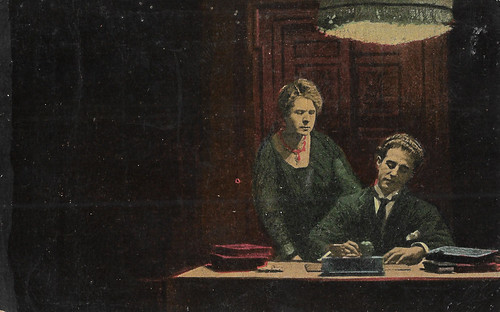
Spanish cromo by Chocolate Imperial in the Series 'Los siete pecados capitales' (The Seven Capital Sins), no. 1. Photo: Caesar Film / Spanish distr. J. Gurgui, Barcelona. Nella Montagna in L'orgoglio/La superbia (Edoardo Bencivenga, 1918). The Spanish film title was Soberbia.
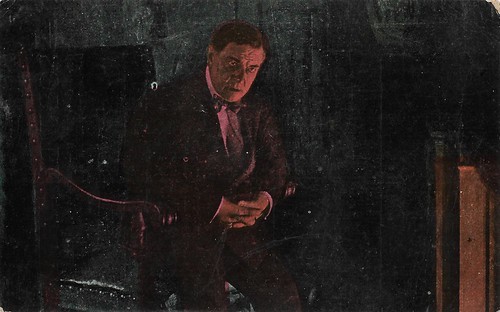
Spanish cromo by Chocolate Imperial in the Series 'Los siete pecados capitales' (The Seven Capital Sins), no. 2. Photo: Caesar Film / Spanish distr. J. Gurgui, Barcelona. Publicity still for L'orgoglio/La superbia (Edoardo Bencivenga, 1918).
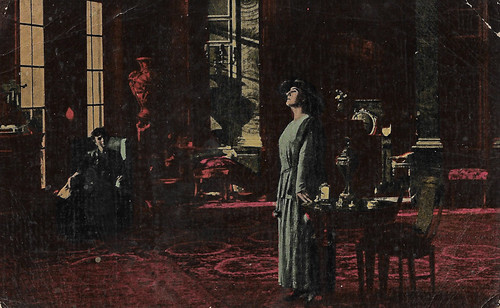
Spanish cromo by Chocolate Imperial in the Series 'Los siete pecados capitales' (The Seven Capital Sins), no. 7. Photo: Caesar Film / Spanish distr. J. Gurgui, Barcelona. Francesca Bertini in L'orgoglio/La superbia (Edoardo Bencivenga, 1918).
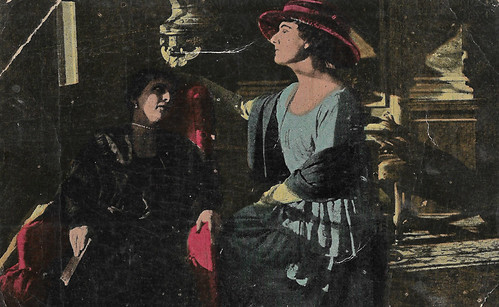
Spanish cromo by Chocolate Imperial in the Series 'Los siete pecados capitales' (The Seven Capital Sins), no. 8. Photo: Caesar Film / Spanish distr. J. Gurgui, Barcelona. Francesca Bertini (right) in L'orgoglio/La superbia (Edoardo Bencivenga, 1918).

Spanish cromo by Chocolate Imperial in the Series 'Los siete pecados capitales' (The Seven Capital Sins), no. 9. Photo: Caesar Film / Spanish distr. J. Gurgui, Barcelona. Nella Montagna and Cia Fornaroli in L'orgoglio/La superbia (Edoardo Bencivenga, 1918).

Spanish cromo by Chocolate Imperial in the Series 'Los siete pecados capitales' (The Seven Capital Sins), no. 10. Photo: Caesar Film / Spanish distr. J. Gurgui, Barcelona. Cia Fornaroli and Francesca Bertini in L'orgoglio/La superbia (Edoardo Bencivenga, 1918).
The fruit of a sinful relationship
I sette peccati capitali (The Seven Capital Sins) was a series of films directed in 1918-1919 by various directors but always starring Italian diva Francesca Bertini . The episode L'orgoglio/La superbia/Pride (1918) and Soberbia in Spanish, was directed by Edoardo Bencivenga. The series was inspired by Eugène Sue's popular novel 'Les sept péchés capitaux'. Sue was a famed serial writer, well known for 'Les mystères de Paris' (1842-1843). The plot of the film as described in Vittorio Martinelli's 'Il cinema muto italiano, Vol. 1918', is partly incorrect. We used the original Spanish leaflets, issued in Spain by Caesar Film, which are in our collection. The order of the numbers on our Spanish Cromos (indicated on the back) may not be synchronous with the order of the plot, but the moments of the plot are clearly recognisable.
In L'orgoglio/La superbia (Edoardo Bencivenga, 1918), politician Ubaldo Maillefort hears his powerful enemies are about to have him arrested, so he gives his daughter in custody to an honorable family. Before leaving he hangs a medallion around her neck with the portrait of her mother, countess Maria de Beaumesnil. The portrait will play an essential role later on. The love between Maria and Ubaldo was not allowed because of her proud and old-fashioned parents. None but the old servant of Ubaldo knows about the secret and he is arrested, and the baby is raised by a good woman who names her Erminia, raises her as if she was her own child, and lets her study to become a professional pianist.
Meanwhile, her real mother has been forced to marry count Villepreux, and they have a daughter Ernestina (Cia Fornaroli). After getting amnesty, Ubaldo returns, while the countess, now widowed, is nearing her end. Not knowing her real parents, Erminia starts to work for the countess and discovers through the medallion that she is her mother. However, the countess dies without having recognised her daughter. Devastated, Erminia realises that she is the fruit of a sinful relationship and decides not to tell out of respect.
The haughty duchess de Santerre (Nella Montagna) is now charged with the guardianship of Ernestina, her niece. At the pompous funeral, Erminia is the only one to really shed tears. Afterward, the duchess pays Erminia for her services, but the latter refuses the humiliating money. Gerardo de Santerre overhears the dialogue and falls in love with her. Hiding his name he courts her, but when his friend, the engineer Oliviero, tells her who he is, she proudly rejects Gerardo.
Meanwhile, Ernestina, fed up with the courting men around her, focuses on charity. Visiting an attic in the house where Erminia also lives, she is overwhelmed by a gang of crooks, but Erminia at gunpoint pushes the malefactors back. Oliviero, who has followed Erminia, witnesses the scene. Love is born between Oliviero and Ernestina, while Gerardo curses his nobility causing Erminia's refusal.
When he tells his mother of his plans she blankly refuses, no duke with a commoner! Instead, Oliviero's parents have no problems with Ernestina as his future bride. Gerardo proposes himself to Erminia, but she only accepts if the duchess comes to ask for her hand. Gerardo is on the verge of suicide and writes so to his mother, who then finally gives in. It is then that Erminia reveals she is the countess of Beausmenil and thus half-sister of Ernestina. When the old countess finally falls on her knees for Erminia, begging for Gerardo's life, Erminia is moved and embraces her with both arms.
Although launched with a big campaign, the series I sette peccati capitali was less successful at the time than expected. The integral version of I sette peccati capitali was believed lost until it was discovered at the Prague Film Institute (Ceskoslovensky Filmovy Archiv). It was carefully restored including the tinting and shown at Il Cinema Ritrovato in Bologna in 1991 (the first restorations of L'avarizia and L'orgoglio), and in 2003 the complete series.
The seven pictures of I sette peccati capitali are L'orgoglio/La superbia/Pride, Gula/Gluttony, Ira/Wrath and L'avarizia/Greed (1918), L'invidia/Envy, L'accidia/Sloth and Lussuria/Lust (1919). Judging from the photos in the Spanish leaflets, Gregorio was possibly played by Livio Pavanelli but his name is unmentioned in all sources on Bertini, IMDb, etc. Of course, the photos on the leaflets may have been misplaced. Guido Trento probably played Oliviero. It is also unclear who played Maillefort, the countess de Beaumesnil, and the old servant. The name of Renato Trento is mentioned in many sources but we could not trace any pictures of him.
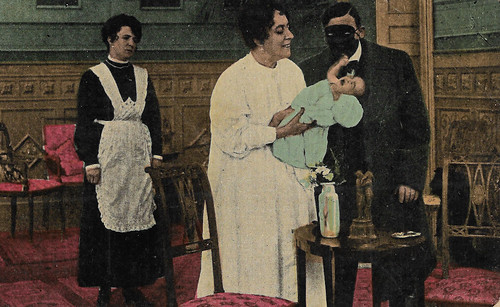
Spanish cromo by Chocolate Imperial in the Series 'Los siete pecados capitales' (The Seven Capital Sins), no. 11. Photo: Caesar Film / Spanish distr. J. Gurgui, Barcelona. Publicity still for L'orgoglio/La superbia (Edoardo Bencivenga, 1918).
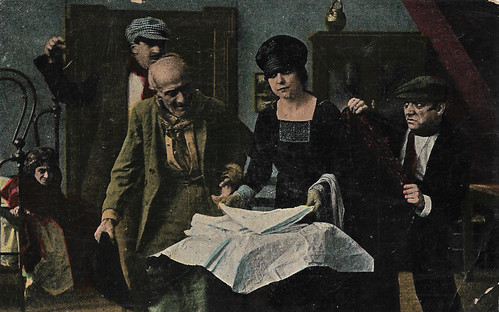
Spanish cromo by Chocolate Imperial in the Series 'Los siete pecados capitales' (The Seven Capital Sins), no. 12. Photo: Caesar Film / Spanish distr. J. Gurgui, Barcelona. Cia Fornaroli in L'orgoglio/La superbia (Edoardo Bencivenga, 1918).
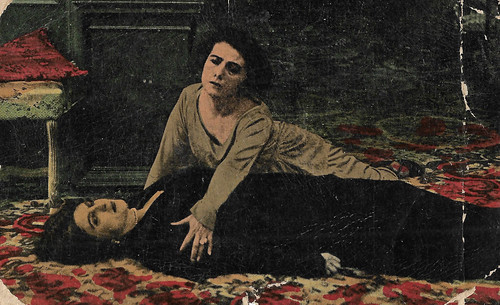
Spanish cromo by Chocolate Imperial in the Series 'Los siete pecados capitales' (The Seven Capital Sins), no. 14. Photo: Caesar Film / Spanish distr. J. Gurgui, Barcelona. Francesca Bertini as Emilia in L'orgoglio/La superbia (Edoardo Bencivenga, 1918). Erminia recognizes countess Maria as her mother, but the latter dies before reconciliation can take place and Erminia keeps silent about her birth out of wedlock.
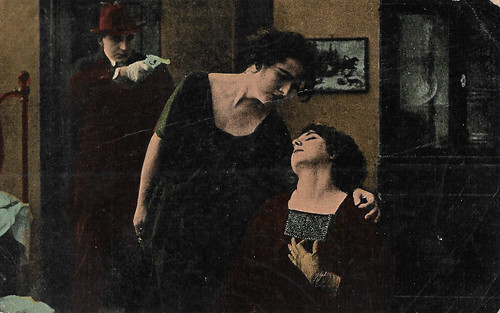
Spanish cromo by Chocolate Imperial in the Series 'Los siete pecados capitales' (The Seven Capital Sins), no. 15. Photo: Caesar Film / Spanish distr. J. Gurgui, Barcelona. Francesca Bertini and Cia Fornaroli in L'orgoglio/La superbia (Edoardo Bencivenga, 1918).
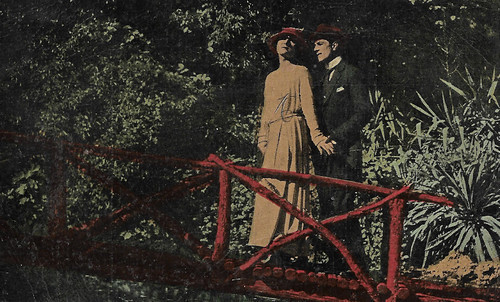
Spanish cromo by Chocolate Imperial in the Series 'Los siete pecados capitales' (The Seven Capital Sins), no. 16. Photo: Caesar Film / Spanish distr. J. Gurgui, Barcelona. Francesca Bertini in L'orgoglio/La superbia (Edoardo Bencivenga, 1918).
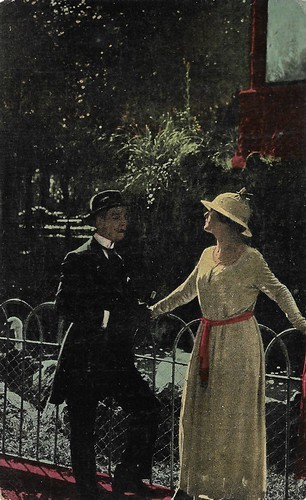
Spanish cromo by Chocolate Imperial in the Series 'Los siete pecados capitales' (The Seven Capital Sins), no. 17. Photo: Caesar Film / Spanish distr. J. Gurgui, Barcelona. Francesca Bertini in L'orgoglio/La superbia (Edoardo Bencivenga, 1918).
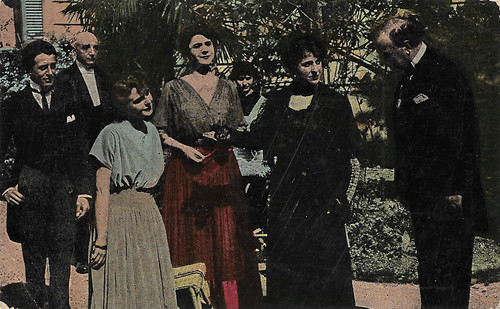
Spanish cromo by Chocolate Imperial in the Series 'Los siete pecados capitales' (The Seven Capital Sins), no. 18. Photo: Caesar Film / Spanish distr. J. Gurgui, Barcelona. The widowed countess Maria (unknown actress), her daughter Ernestina (Cia Fornaroli), and between them, their relative, the proud duchess of Santerre (Nella Montagna) in L'orgoglio/La superbia (Edoardo Bencivenga, 1918).
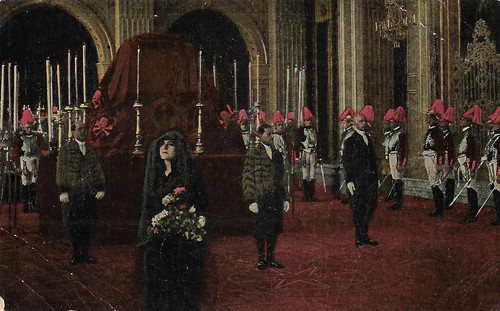
Spanish cromo by Chocolate Imperial in the Series 'Los siete pecados capitales' (The Seven Capital Sins), no. 19. Photo: Caesar Film / Spanish distr. J. Gurgui, Barcelona. Francesca Bertini as Erminia in L'orgoglio/La superbia (Edoardo Bencivenga, 1918). Erminia is the only one to shed tears at her mother's funeral.
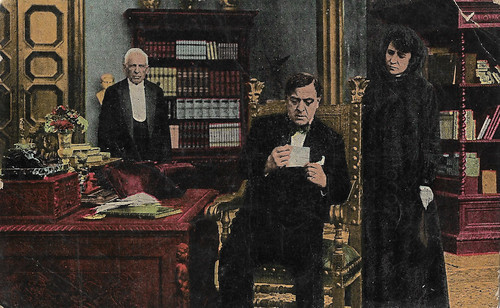
Spanish cromo by Chocolate Imperial in the Series 'Los siete pecados capitales' (The Seven Capital Sins), no. 20. Photo: Caesar Film / Spanish distr. J. Gurgui, Barcelona. Francesca Bertini in L'orgoglio/La superbia (Edoardo Bencivenga, 1918).
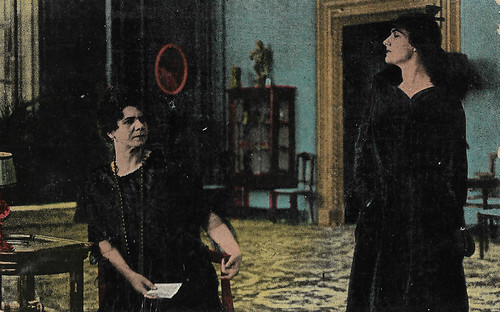
Spanish cromo by Chocolate Imperial in the Series 'Los siete pecados capitales' (The Seven Capital Sins), no. 21. Photo: Caesar Film / Spanish distr. J. Gurgui, Barcelona. Francesca Bertini (right) and Nella Montagna in L'orgoglio/La superbia (Edoardo Bencivenga, 1918).
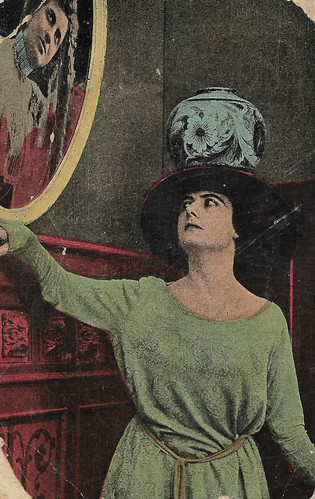
Spanish cromo by Chocolate Imperial in the Series 'Los siete pecados capitales' (The Seven Capital Sins), no. 22. Photo: Caesar Film / Spanish distr. J. Gurgui, Barcelona. Francesca Bertini as Erminia in L'orgoglio/La superbia (Edoardo Bencivenga, 1918). Erminia watches the portrait of her deceased mother.
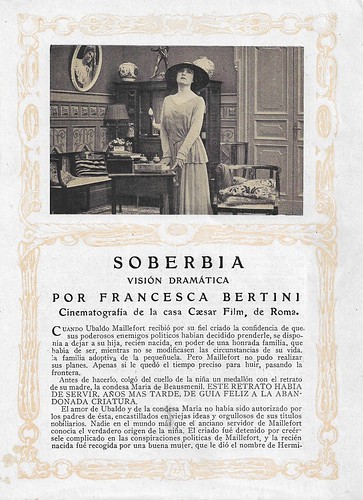
Frontside of a Spanish brochure by Caesar Film for the Italian silent film L'orgoglio/La superbia (Edoardo Bencivenga, 1918).
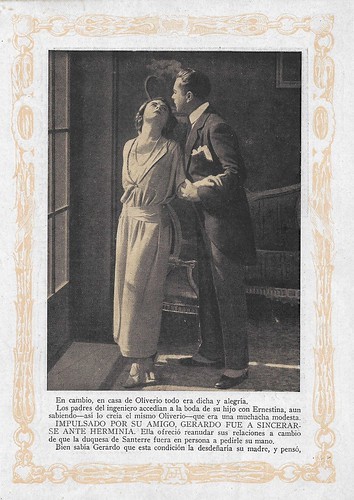
One page of the Spanish brochure by Caesar Film for the Italian silent film L'orgoglio/La superbia (Edoardo Bencivenga, 1918), starring Francesca Bertini . The man looks like Livio Pavanelli .
Sources: original Spanish leaflets by Caesar Film and IMDb.

Spanish cromo by Chocolate Imperial in the Series 'Los siete pecados capitales' (The Seven Capital Sins), no. 1. Photo: Caesar Film / Spanish distr. J. Gurgui, Barcelona. Nella Montagna in L'orgoglio/La superbia (Edoardo Bencivenga, 1918). The Spanish film title was Soberbia.

Spanish cromo by Chocolate Imperial in the Series 'Los siete pecados capitales' (The Seven Capital Sins), no. 2. Photo: Caesar Film / Spanish distr. J. Gurgui, Barcelona. Publicity still for L'orgoglio/La superbia (Edoardo Bencivenga, 1918).

Spanish cromo by Chocolate Imperial in the Series 'Los siete pecados capitales' (The Seven Capital Sins), no. 7. Photo: Caesar Film / Spanish distr. J. Gurgui, Barcelona. Francesca Bertini in L'orgoglio/La superbia (Edoardo Bencivenga, 1918).

Spanish cromo by Chocolate Imperial in the Series 'Los siete pecados capitales' (The Seven Capital Sins), no. 8. Photo: Caesar Film / Spanish distr. J. Gurgui, Barcelona. Francesca Bertini (right) in L'orgoglio/La superbia (Edoardo Bencivenga, 1918).

Spanish cromo by Chocolate Imperial in the Series 'Los siete pecados capitales' (The Seven Capital Sins), no. 9. Photo: Caesar Film / Spanish distr. J. Gurgui, Barcelona. Nella Montagna and Cia Fornaroli in L'orgoglio/La superbia (Edoardo Bencivenga, 1918).

Spanish cromo by Chocolate Imperial in the Series 'Los siete pecados capitales' (The Seven Capital Sins), no. 10. Photo: Caesar Film / Spanish distr. J. Gurgui, Barcelona. Cia Fornaroli and Francesca Bertini in L'orgoglio/La superbia (Edoardo Bencivenga, 1918).
The fruit of a sinful relationship
I sette peccati capitali (The Seven Capital Sins) was a series of films directed in 1918-1919 by various directors but always starring Italian diva Francesca Bertini . The episode L'orgoglio/La superbia/Pride (1918) and Soberbia in Spanish, was directed by Edoardo Bencivenga. The series was inspired by Eugène Sue's popular novel 'Les sept péchés capitaux'. Sue was a famed serial writer, well known for 'Les mystères de Paris' (1842-1843). The plot of the film as described in Vittorio Martinelli's 'Il cinema muto italiano, Vol. 1918', is partly incorrect. We used the original Spanish leaflets, issued in Spain by Caesar Film, which are in our collection. The order of the numbers on our Spanish Cromos (indicated on the back) may not be synchronous with the order of the plot, but the moments of the plot are clearly recognisable.
In L'orgoglio/La superbia (Edoardo Bencivenga, 1918), politician Ubaldo Maillefort hears his powerful enemies are about to have him arrested, so he gives his daughter in custody to an honorable family. Before leaving he hangs a medallion around her neck with the portrait of her mother, countess Maria de Beaumesnil. The portrait will play an essential role later on. The love between Maria and Ubaldo was not allowed because of her proud and old-fashioned parents. None but the old servant of Ubaldo knows about the secret and he is arrested, and the baby is raised by a good woman who names her Erminia, raises her as if she was her own child, and lets her study to become a professional pianist.
Meanwhile, her real mother has been forced to marry count Villepreux, and they have a daughter Ernestina (Cia Fornaroli). After getting amnesty, Ubaldo returns, while the countess, now widowed, is nearing her end. Not knowing her real parents, Erminia starts to work for the countess and discovers through the medallion that she is her mother. However, the countess dies without having recognised her daughter. Devastated, Erminia realises that she is the fruit of a sinful relationship and decides not to tell out of respect.
The haughty duchess de Santerre (Nella Montagna) is now charged with the guardianship of Ernestina, her niece. At the pompous funeral, Erminia is the only one to really shed tears. Afterward, the duchess pays Erminia for her services, but the latter refuses the humiliating money. Gerardo de Santerre overhears the dialogue and falls in love with her. Hiding his name he courts her, but when his friend, the engineer Oliviero, tells her who he is, she proudly rejects Gerardo.
Meanwhile, Ernestina, fed up with the courting men around her, focuses on charity. Visiting an attic in the house where Erminia also lives, she is overwhelmed by a gang of crooks, but Erminia at gunpoint pushes the malefactors back. Oliviero, who has followed Erminia, witnesses the scene. Love is born between Oliviero and Ernestina, while Gerardo curses his nobility causing Erminia's refusal.
When he tells his mother of his plans she blankly refuses, no duke with a commoner! Instead, Oliviero's parents have no problems with Ernestina as his future bride. Gerardo proposes himself to Erminia, but she only accepts if the duchess comes to ask for her hand. Gerardo is on the verge of suicide and writes so to his mother, who then finally gives in. It is then that Erminia reveals she is the countess of Beausmenil and thus half-sister of Ernestina. When the old countess finally falls on her knees for Erminia, begging for Gerardo's life, Erminia is moved and embraces her with both arms.
Although launched with a big campaign, the series I sette peccati capitali was less successful at the time than expected. The integral version of I sette peccati capitali was believed lost until it was discovered at the Prague Film Institute (Ceskoslovensky Filmovy Archiv). It was carefully restored including the tinting and shown at Il Cinema Ritrovato in Bologna in 1991 (the first restorations of L'avarizia and L'orgoglio), and in 2003 the complete series.
The seven pictures of I sette peccati capitali are L'orgoglio/La superbia/Pride, Gula/Gluttony, Ira/Wrath and L'avarizia/Greed (1918), L'invidia/Envy, L'accidia/Sloth and Lussuria/Lust (1919). Judging from the photos in the Spanish leaflets, Gregorio was possibly played by Livio Pavanelli but his name is unmentioned in all sources on Bertini, IMDb, etc. Of course, the photos on the leaflets may have been misplaced. Guido Trento probably played Oliviero. It is also unclear who played Maillefort, the countess de Beaumesnil, and the old servant. The name of Renato Trento is mentioned in many sources but we could not trace any pictures of him.

Spanish cromo by Chocolate Imperial in the Series 'Los siete pecados capitales' (The Seven Capital Sins), no. 11. Photo: Caesar Film / Spanish distr. J. Gurgui, Barcelona. Publicity still for L'orgoglio/La superbia (Edoardo Bencivenga, 1918).

Spanish cromo by Chocolate Imperial in the Series 'Los siete pecados capitales' (The Seven Capital Sins), no. 12. Photo: Caesar Film / Spanish distr. J. Gurgui, Barcelona. Cia Fornaroli in L'orgoglio/La superbia (Edoardo Bencivenga, 1918).

Spanish cromo by Chocolate Imperial in the Series 'Los siete pecados capitales' (The Seven Capital Sins), no. 14. Photo: Caesar Film / Spanish distr. J. Gurgui, Barcelona. Francesca Bertini as Emilia in L'orgoglio/La superbia (Edoardo Bencivenga, 1918). Erminia recognizes countess Maria as her mother, but the latter dies before reconciliation can take place and Erminia keeps silent about her birth out of wedlock.

Spanish cromo by Chocolate Imperial in the Series 'Los siete pecados capitales' (The Seven Capital Sins), no. 15. Photo: Caesar Film / Spanish distr. J. Gurgui, Barcelona. Francesca Bertini and Cia Fornaroli in L'orgoglio/La superbia (Edoardo Bencivenga, 1918).

Spanish cromo by Chocolate Imperial in the Series 'Los siete pecados capitales' (The Seven Capital Sins), no. 16. Photo: Caesar Film / Spanish distr. J. Gurgui, Barcelona. Francesca Bertini in L'orgoglio/La superbia (Edoardo Bencivenga, 1918).

Spanish cromo by Chocolate Imperial in the Series 'Los siete pecados capitales' (The Seven Capital Sins), no. 17. Photo: Caesar Film / Spanish distr. J. Gurgui, Barcelona. Francesca Bertini in L'orgoglio/La superbia (Edoardo Bencivenga, 1918).

Spanish cromo by Chocolate Imperial in the Series 'Los siete pecados capitales' (The Seven Capital Sins), no. 18. Photo: Caesar Film / Spanish distr. J. Gurgui, Barcelona. The widowed countess Maria (unknown actress), her daughter Ernestina (Cia Fornaroli), and between them, their relative, the proud duchess of Santerre (Nella Montagna) in L'orgoglio/La superbia (Edoardo Bencivenga, 1918).

Spanish cromo by Chocolate Imperial in the Series 'Los siete pecados capitales' (The Seven Capital Sins), no. 19. Photo: Caesar Film / Spanish distr. J. Gurgui, Barcelona. Francesca Bertini as Erminia in L'orgoglio/La superbia (Edoardo Bencivenga, 1918). Erminia is the only one to shed tears at her mother's funeral.

Spanish cromo by Chocolate Imperial in the Series 'Los siete pecados capitales' (The Seven Capital Sins), no. 20. Photo: Caesar Film / Spanish distr. J. Gurgui, Barcelona. Francesca Bertini in L'orgoglio/La superbia (Edoardo Bencivenga, 1918).

Spanish cromo by Chocolate Imperial in the Series 'Los siete pecados capitales' (The Seven Capital Sins), no. 21. Photo: Caesar Film / Spanish distr. J. Gurgui, Barcelona. Francesca Bertini (right) and Nella Montagna in L'orgoglio/La superbia (Edoardo Bencivenga, 1918).

Spanish cromo by Chocolate Imperial in the Series 'Los siete pecados capitales' (The Seven Capital Sins), no. 22. Photo: Caesar Film / Spanish distr. J. Gurgui, Barcelona. Francesca Bertini as Erminia in L'orgoglio/La superbia (Edoardo Bencivenga, 1918). Erminia watches the portrait of her deceased mother.

Frontside of a Spanish brochure by Caesar Film for the Italian silent film L'orgoglio/La superbia (Edoardo Bencivenga, 1918).

One page of the Spanish brochure by Caesar Film for the Italian silent film L'orgoglio/La superbia (Edoardo Bencivenga, 1918), starring Francesca Bertini . The man looks like Livio Pavanelli .
Sources: original Spanish leaflets by Caesar Film and IMDb.
Published on July 30, 2021 22:00
July 29, 2021
Constance Bennett
Independent, outspoken Constance Bennett (1904-1965) was a Hollywood star of the 1920s and 1930s. Her classy blonde looks, husky voice, and unerring fashion sense gave her a distinctive style. In the early 1930s, she was for a time Hollywood's most popular and best-paid star and is known for e.g. What Price Hollywood? (George Cukor, 1932). She was the older sister of actress Joan Bennett.
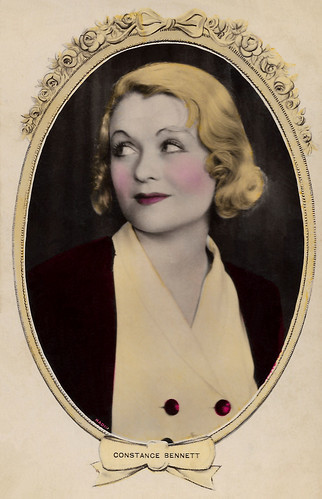
British postcard in the Cameo Series, London, no. KC 9.
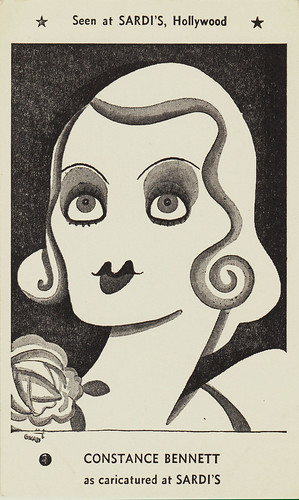
American postcard published by Sardi’s. Caricature by Joe Grant. Collection: Marlene Pilaete.
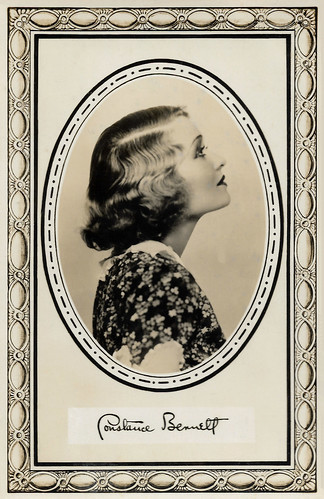
British postcard in the Autograph Series, London, no. A 18.
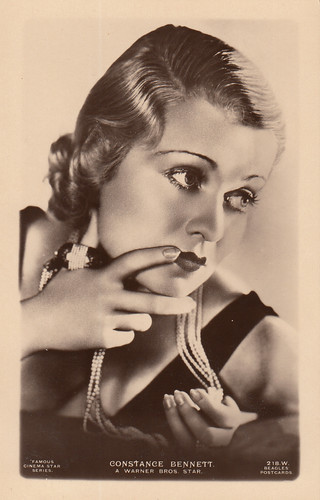
British postcard in the Famous Cinema Star Series by Beagles, no. 218w. Photo: Warner Bros. Collection: Marlene Pilaete.
Independent, cultured, ironic, and outspoken
Constance Campbell Bennett was born in 1904 in New York City. She was the eldest of three daughters of actress Adrienne Morrison and actor Richard Bennett. Her younger sisters were actresses Joan Bennett and Barbara Bennett. All three girls attended the Chapin School in New York.
Hal Erickson at AllMovie : "Though her father did everything he could to discourage her from pursuing an acting career, Constance was willful and rebellious almost from the moment of her birth."
After some time spent in a convent, Bennett went into the family business. Independent, cultured, ironic, and outspoken, Constance, the first Bennett sister to enter motion pictures, appeared in New York-produced silent films before a meeting with Samuel Goldwyn led to her Hollywood debut in Cytherea (George Fitzmaurice, 1924).
Hal Erickson: "She treated her silent-film career as a lark, but along the way she developed a superb sense of comic timing and an instinctive gift for heavy dramatics." She abandoned her burgeoning career in silents for marriage to Philip Plant in 1925 but resumed her film career after their divorce.
With the advent of talking pictures, and with her delicate blonde features and glamorous fashion style, she quickly became a popular film star. In the early 1930s, Bennett was frequently among the top actresses named in audience popularity and box-office polls. The hit Common Clay (Victor Fleming, 1930) launched her in a series of loose lady and unwed mother roles.
For a short time, she was the highest-paid actress in Hollywood. So successful was Bennett during this time, that RKO, Bennett's home studio at the time, controlled the careers of actresses Ann Harding and Helen Twelvetrees in a similar manner, hoping to duplicate Bennett's success.
In 1931, a short-lived contract with Metro-Goldwyn-Mayer earned her $300,000 for two films which included The Easiest Way (Jack Conway, 1931) and made her one of the highest-paid stars in Hollywood. Warner Brothers paid her the all-time high salary of $30,000 a week for Bought! (Archie Mayo, 1931). Richard Bennett, her father, was also cast in this film.
The next year she moved to RKO, where she acted in What Price Hollywood? (George Cukor, 1932), an ironic and at the same time tragic behind-the-scenes looks at the old Hollywood studio system, in which she portrayed waitress Mary Evans, who becomes a movie star. Lowell Sherman co-starred as the film director who discovers her, and Neil Hamilton was the wealthy playboy she marries. It was a critical and box office hit.
The film Morning Glory (Lowell Sherman, 1933) had been written with Bennett in mind for the lead role, but producer Pandro S. Berman gave the role to Katharine Hepburn , who won an Academy Award for her performance. Bennett next showed her versatility in the likes of Our Betters (George Cukor, 1933), writer/director Gregory La Cava's Bed of Roses (1933) with Joel McCrea, and After Tonight (George Archainbaud, 1933) in which she co-starred with future husband Gilbert Roland.
Next, she appeared in The Affairs of Cellini (Gregory La Cava, 1934), After Office Hours (Robert Z. Leonard, 1935) with Clark Gable , and the original Topper (Norman Z. McLeod, 1937), in a career standout as Marian Kerby opposite Cary Grant . She repeated the role in the sequel, Topper Takes a Trip (Norman Z. McLeod, 1939). Then followed the ultimate madcap family comedy Merrily We Live (Norman Z. McLeod, 1938) and Two-Faced Woman (George Cukor, 1941) in which she supported Greta Garbo .
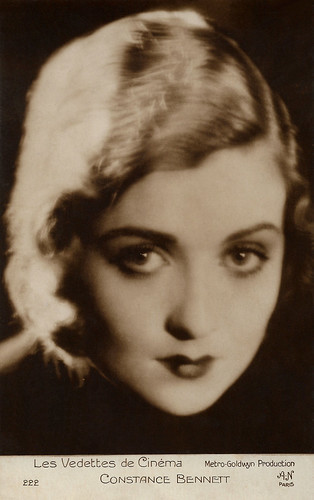
French postcard in the Les Vedettes de Cinéma series by A.N., Paris, no. 222. Photo: Metro-Goldwyn Production.
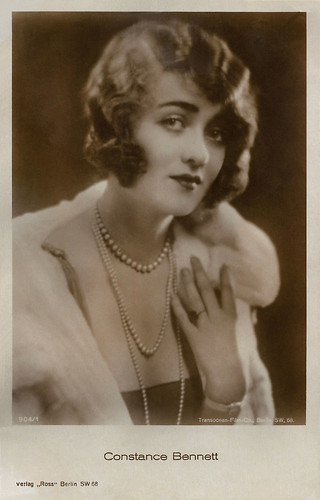
German postcard by Ross Verlag, Berlin, no. 904/1, 1925-1926. Photo: Transocean Film Co., Berlin.
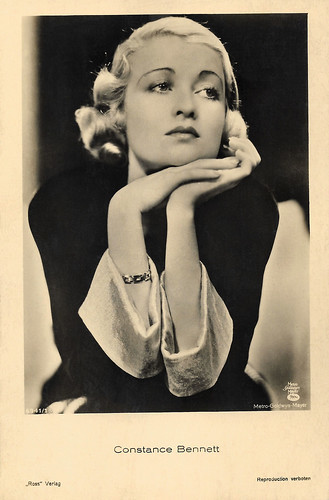
German postcard by Ross Verlag, Berlin, no. 6941/1, 1931-1932. Photo: Metro-Goldwyn-Mayer.
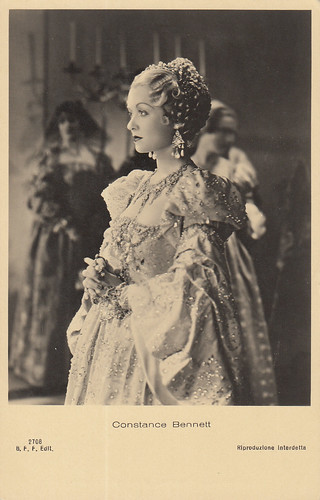
Italian postcard by B. F. F. Edit., no. 2708. Collection: Marlene Pilaete. Constance Bennett in The Affairs of Cellini (Gregory La Cava, 1934).
Marrying a well-known playboy of questionable royal lineage
By the 1940s, Constance Bennett was working less frequently in films but was in demand in both radio and theatre. Her stage acting debut was Noël Coward's 'Easy Virtue' (1940). She had her own program, 'Constance Bennett Calls on You', on ABC radio in 1945-1946. Shrewd investments had made her a wealthy woman, and she founded a cosmetics and clothing company.
Bennett was married five times and had three children. In 1921, Bennett eloped with Chester Hirst Moorehead, a student at the University of Virginia. Bennett was 16 at the time and her parents were opposed to their marriage solely on account of their youth. The marriage was annulled in 1923.
Bennett's next serious relationship was with millionaire socialite Philip Morgan Plant. Her parents planned a cruise to Europe, taking Constance with them, to separate the couple. As the ship was preparing to leave port, however, the Bennetts saw Plant and his parents boarding, too. A contemporary newspaper article reported, "Now the little beauty and the heir to all the Plant millions were assured a week of the cosy intimacy which an ocean liner affords." In 1925, the two eloped and were married and they divorced in a French court in 1929.
In 1932, Bennett returned from Europe with a three-year-old child, whom she claimed to have adopted and named Peter Bennett Plant (1929). In 1942, however, during a battle over a large trust fund established to benefit any descendants of her former husband, Bennett announced that her adopted son actually was her natural child by Plant, born after the divorce and kept hidden to ensure that the child's biological father did not get custody. During the court hearings, the actress told her former mother-in-law and her husband's widow that "if she got to the witness stand she would give a complete account of her life with Plant." The matter was settled out of court.
In 1931, Bennett made headlines when she married one of Gloria Swanson 's former husbands, Henri le Bailly, the Marquis de La Coudraye de La Falaise, a well-known playboy of questionable royal lineage. She and de la Falaise founded Bennett Pictures Corp. and co-produced two films which were the last filmed in Hollywood in the two-strip Technicolor process, Legong: Dance of the Virgins (Henri de La Falaise, 1935) filmed in Bali, and Kilou the Killer Tiger (Henri de La Falaise, 1936), filmed in Indochina. They were divorced in Reno, Nevada in 1940.
Bennett's fourth marriage was to actor Gilbert Roland. They were married in 1941 and had two daughters, Lorinda "Lynda" (1938) and Christina "Gyl" (1941). They divorced in 1946, with Bennett winning custody of their children. Later that year, Bennett married for the fifth and final time to US Air Force Colonel (later Brigadier General) John Theron Coulter. After her marriage, she concentrated her efforts on providing relief entertainment to US troops still stationed in Europe, winning military honors for her services. Bennett and Coulter remained married until her death in 1965.
In 1947, Bennett had a major supporting role in The Unsuspected (Michael Curtiz, 1947), in which she played Jane Moynihan, the program director who helps prove that radio host Victor Grandison ( Claude Rains ) is guilty of murder. In 1957–1958, she toured the United States in the title role of 'Auntie Mame', and in 1945-1946, she hosted 'The Constance Bennett Show' on ABC Radio.
In the 1950s, As Young as You Feel (Harmon Jones, 1951) found her playing opposite a young Marilyn Monroe , and she played herself in a cameo in It Should Happen to You (George Cukor, 1954). Bennett made her final screen appearance in Madame X (David Lowell Rich, 1966) as the blackmailing mother-in-law of Lana Turner .
Shortly after the filming of Madame X was completed, Bennett collapsed and died from a cerebral hemorrhage at the age of 60. In recognition of her military contributions, and as the wife of John Theron Coulter, who had achieved the rank of brigadier general, she was buried in Arlington National Cemetery. Coulter died in 1995 and was buried with her. Bennett has a motion pictures star on the Hollywood Walk of Fame for her contributions to the film industry. Her star is located at 6250 Hollywood Boulevard, a short distance from the star of her sister, Joan.
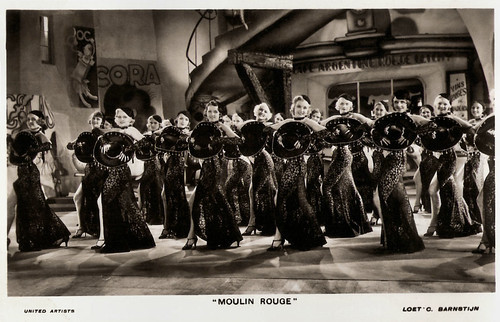
Dutch postcard by Loet C. Barnstijn. Photo: United Artists / 20th Century. Constance Bennett in Moulin Rouge (Sidney Lanfield, 1934).
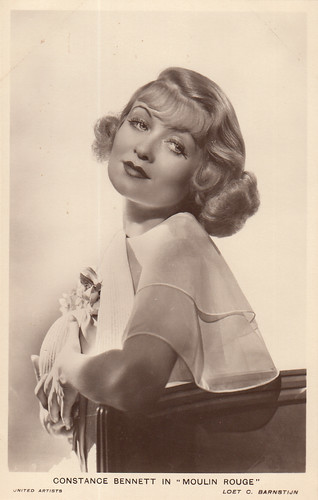
Dutch postcard by Loet G. Barnstijn. Photo: United Artists / 20th Century. Constance Bennett in Moulin Rouge (Sidney Lanfield, 1934). Collection: Marlene Pilaete.
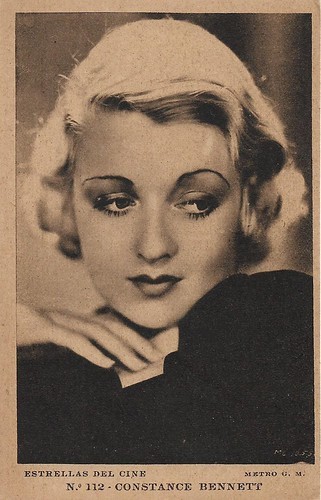
Spanish postcard in the Estrellas del cine series by Editorial Grafica, Barcelona, no. 112. Photo: Metro-Goldwyn-Mayer.
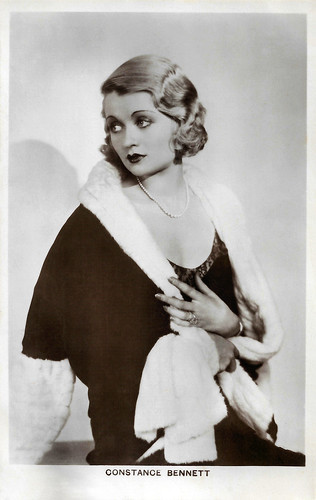
British postcard.
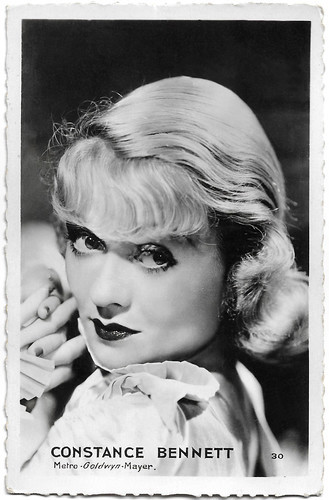
French postcard by Edit. Chantal, Rueil (S.-O.), no. 30. Photo: Metro-Goldwyn-Mayer.
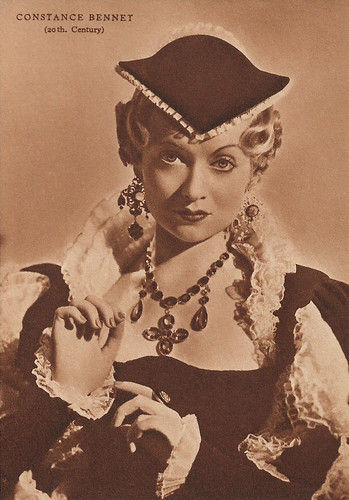
Italian postcard by Rizzoli & C. Milano, 1938. Photo: 20th Century. Constance Bennett in The Affairs of Cellini (Gregory La Cava, 1934).
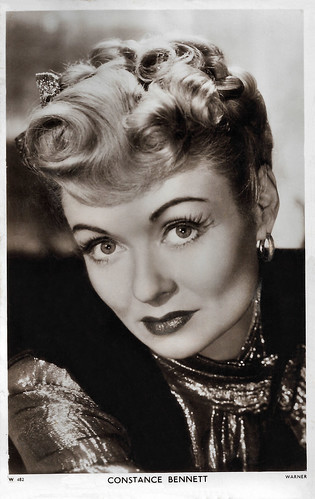
British postcard in the Picturegoer Series, London, no. W. 482. Photo: Warner.
Sources: Hal Erickson (AllMovie), (IMDb), Wikipedia, and .

British postcard in the Cameo Series, London, no. KC 9.

American postcard published by Sardi’s. Caricature by Joe Grant. Collection: Marlene Pilaete.

British postcard in the Autograph Series, London, no. A 18.

British postcard in the Famous Cinema Star Series by Beagles, no. 218w. Photo: Warner Bros. Collection: Marlene Pilaete.
Independent, cultured, ironic, and outspoken
Constance Campbell Bennett was born in 1904 in New York City. She was the eldest of three daughters of actress Adrienne Morrison and actor Richard Bennett. Her younger sisters were actresses Joan Bennett and Barbara Bennett. All three girls attended the Chapin School in New York.
Hal Erickson at AllMovie : "Though her father did everything he could to discourage her from pursuing an acting career, Constance was willful and rebellious almost from the moment of her birth."
After some time spent in a convent, Bennett went into the family business. Independent, cultured, ironic, and outspoken, Constance, the first Bennett sister to enter motion pictures, appeared in New York-produced silent films before a meeting with Samuel Goldwyn led to her Hollywood debut in Cytherea (George Fitzmaurice, 1924).
Hal Erickson: "She treated her silent-film career as a lark, but along the way she developed a superb sense of comic timing and an instinctive gift for heavy dramatics." She abandoned her burgeoning career in silents for marriage to Philip Plant in 1925 but resumed her film career after their divorce.
With the advent of talking pictures, and with her delicate blonde features and glamorous fashion style, she quickly became a popular film star. In the early 1930s, Bennett was frequently among the top actresses named in audience popularity and box-office polls. The hit Common Clay (Victor Fleming, 1930) launched her in a series of loose lady and unwed mother roles.
For a short time, she was the highest-paid actress in Hollywood. So successful was Bennett during this time, that RKO, Bennett's home studio at the time, controlled the careers of actresses Ann Harding and Helen Twelvetrees in a similar manner, hoping to duplicate Bennett's success.
In 1931, a short-lived contract with Metro-Goldwyn-Mayer earned her $300,000 for two films which included The Easiest Way (Jack Conway, 1931) and made her one of the highest-paid stars in Hollywood. Warner Brothers paid her the all-time high salary of $30,000 a week for Bought! (Archie Mayo, 1931). Richard Bennett, her father, was also cast in this film.
The next year she moved to RKO, where she acted in What Price Hollywood? (George Cukor, 1932), an ironic and at the same time tragic behind-the-scenes looks at the old Hollywood studio system, in which she portrayed waitress Mary Evans, who becomes a movie star. Lowell Sherman co-starred as the film director who discovers her, and Neil Hamilton was the wealthy playboy she marries. It was a critical and box office hit.
The film Morning Glory (Lowell Sherman, 1933) had been written with Bennett in mind for the lead role, but producer Pandro S. Berman gave the role to Katharine Hepburn , who won an Academy Award for her performance. Bennett next showed her versatility in the likes of Our Betters (George Cukor, 1933), writer/director Gregory La Cava's Bed of Roses (1933) with Joel McCrea, and After Tonight (George Archainbaud, 1933) in which she co-starred with future husband Gilbert Roland.
Next, she appeared in The Affairs of Cellini (Gregory La Cava, 1934), After Office Hours (Robert Z. Leonard, 1935) with Clark Gable , and the original Topper (Norman Z. McLeod, 1937), in a career standout as Marian Kerby opposite Cary Grant . She repeated the role in the sequel, Topper Takes a Trip (Norman Z. McLeod, 1939). Then followed the ultimate madcap family comedy Merrily We Live (Norman Z. McLeod, 1938) and Two-Faced Woman (George Cukor, 1941) in which she supported Greta Garbo .

French postcard in the Les Vedettes de Cinéma series by A.N., Paris, no. 222. Photo: Metro-Goldwyn Production.

German postcard by Ross Verlag, Berlin, no. 904/1, 1925-1926. Photo: Transocean Film Co., Berlin.

German postcard by Ross Verlag, Berlin, no. 6941/1, 1931-1932. Photo: Metro-Goldwyn-Mayer.

Italian postcard by B. F. F. Edit., no. 2708. Collection: Marlene Pilaete. Constance Bennett in The Affairs of Cellini (Gregory La Cava, 1934).
Marrying a well-known playboy of questionable royal lineage
By the 1940s, Constance Bennett was working less frequently in films but was in demand in both radio and theatre. Her stage acting debut was Noël Coward's 'Easy Virtue' (1940). She had her own program, 'Constance Bennett Calls on You', on ABC radio in 1945-1946. Shrewd investments had made her a wealthy woman, and she founded a cosmetics and clothing company.
Bennett was married five times and had three children. In 1921, Bennett eloped with Chester Hirst Moorehead, a student at the University of Virginia. Bennett was 16 at the time and her parents were opposed to their marriage solely on account of their youth. The marriage was annulled in 1923.
Bennett's next serious relationship was with millionaire socialite Philip Morgan Plant. Her parents planned a cruise to Europe, taking Constance with them, to separate the couple. As the ship was preparing to leave port, however, the Bennetts saw Plant and his parents boarding, too. A contemporary newspaper article reported, "Now the little beauty and the heir to all the Plant millions were assured a week of the cosy intimacy which an ocean liner affords." In 1925, the two eloped and were married and they divorced in a French court in 1929.
In 1932, Bennett returned from Europe with a three-year-old child, whom she claimed to have adopted and named Peter Bennett Plant (1929). In 1942, however, during a battle over a large trust fund established to benefit any descendants of her former husband, Bennett announced that her adopted son actually was her natural child by Plant, born after the divorce and kept hidden to ensure that the child's biological father did not get custody. During the court hearings, the actress told her former mother-in-law and her husband's widow that "if she got to the witness stand she would give a complete account of her life with Plant." The matter was settled out of court.
In 1931, Bennett made headlines when she married one of Gloria Swanson 's former husbands, Henri le Bailly, the Marquis de La Coudraye de La Falaise, a well-known playboy of questionable royal lineage. She and de la Falaise founded Bennett Pictures Corp. and co-produced two films which were the last filmed in Hollywood in the two-strip Technicolor process, Legong: Dance of the Virgins (Henri de La Falaise, 1935) filmed in Bali, and Kilou the Killer Tiger (Henri de La Falaise, 1936), filmed in Indochina. They were divorced in Reno, Nevada in 1940.
Bennett's fourth marriage was to actor Gilbert Roland. They were married in 1941 and had two daughters, Lorinda "Lynda" (1938) and Christina "Gyl" (1941). They divorced in 1946, with Bennett winning custody of their children. Later that year, Bennett married for the fifth and final time to US Air Force Colonel (later Brigadier General) John Theron Coulter. After her marriage, she concentrated her efforts on providing relief entertainment to US troops still stationed in Europe, winning military honors for her services. Bennett and Coulter remained married until her death in 1965.
In 1947, Bennett had a major supporting role in The Unsuspected (Michael Curtiz, 1947), in which she played Jane Moynihan, the program director who helps prove that radio host Victor Grandison ( Claude Rains ) is guilty of murder. In 1957–1958, she toured the United States in the title role of 'Auntie Mame', and in 1945-1946, she hosted 'The Constance Bennett Show' on ABC Radio.
In the 1950s, As Young as You Feel (Harmon Jones, 1951) found her playing opposite a young Marilyn Monroe , and she played herself in a cameo in It Should Happen to You (George Cukor, 1954). Bennett made her final screen appearance in Madame X (David Lowell Rich, 1966) as the blackmailing mother-in-law of Lana Turner .
Shortly after the filming of Madame X was completed, Bennett collapsed and died from a cerebral hemorrhage at the age of 60. In recognition of her military contributions, and as the wife of John Theron Coulter, who had achieved the rank of brigadier general, she was buried in Arlington National Cemetery. Coulter died in 1995 and was buried with her. Bennett has a motion pictures star on the Hollywood Walk of Fame for her contributions to the film industry. Her star is located at 6250 Hollywood Boulevard, a short distance from the star of her sister, Joan.

Dutch postcard by Loet C. Barnstijn. Photo: United Artists / 20th Century. Constance Bennett in Moulin Rouge (Sidney Lanfield, 1934).

Dutch postcard by Loet G. Barnstijn. Photo: United Artists / 20th Century. Constance Bennett in Moulin Rouge (Sidney Lanfield, 1934). Collection: Marlene Pilaete.

Spanish postcard in the Estrellas del cine series by Editorial Grafica, Barcelona, no. 112. Photo: Metro-Goldwyn-Mayer.

British postcard.

French postcard by Edit. Chantal, Rueil (S.-O.), no. 30. Photo: Metro-Goldwyn-Mayer.

Italian postcard by Rizzoli & C. Milano, 1938. Photo: 20th Century. Constance Bennett in The Affairs of Cellini (Gregory La Cava, 1934).

British postcard in the Picturegoer Series, London, no. W. 482. Photo: Warner.
Sources: Hal Erickson (AllMovie), (IMDb), Wikipedia, and .
Published on July 29, 2021 22:00
Paul van Yperen's Blog
- Paul van Yperen's profile
- 13 followers
Paul van Yperen isn't a Goodreads Author
(yet),
but they
do have a blog,
so here are some recent posts imported from
their feed.



